David Colquhoun
|
In 2009 I asked Napier University Edinburgh for details of what was taught on its herbal medicine "BSc" course. At first it was refused, but then (as often seems to happen when threatened with exposure) the course was closed, and Napier sent what I’d asked for without waiting for the judgement from the Scottish Information Commissioner, |

|
Some samples of the dangerous nonsense that used to be taught on Napier’s herbal medicine course (now closed) have been exposed in “Hot and cold herbal nonsense from Napier University Edinburgh: another course shuts“.
That sadly doesn’t mean that Napier has stopped teaching nonsense. It offers a 3 year Honours BA degree in "reflexology" (the only other place in UCAS is the University of Wales Institute, Cardiff (UWIC), which offers a “BSc(Hons)”, though nine other places offer foundation degrees or HND)
Napier also offers a BA (Hons) in Aromatherapy, according to UCAS
Clearly quackademia has not died entirely yet, though it is on its way. It has closed down entirely at the University of Salford and the University of Central Lancashire. And when I wrote about quackademia in Nature in 2007 there were five "BSc" degrees in homeopathy. Now UCAS does not list a single one. It has even vanished in the home of woo, the University of Westminster.
When I asked Napier for teaching materials used in reflexology and aromatherapy, the request was, as usual. refused. In a letter dated 20 August 2010, David Cloy, Head of Governance & Management Services, wrote that disclosure of the materials “. , would be substantially prejudicial to the Universitys [sic] commercial interests”.
Scotland has its own Freedom of Information (Scotland) Act, and its own Information Commissioner, so it wasn’t possible to rely on the win that I had with the Information Commission (England and Wales). An Appeal was duly lodged on September 3rd 2010. They were a lot faster than before and their decision, dated 9 December 2010, was again almost completely in my favour [download the whole decision]. The decision ended thus.
The Commissioner finds that Edinburgh Napier University (the University) failed to comply with Part 1 of the Freedom of Information (Scotland) Act 2002 (FOISA) in responding to the information request made by Professor Colquhoun. The University wrongly withheld information under section 33(1)(b) of FOISA, and thereby failed to comply with section 1(1) of FOISA. It also failed to provide Professor Colquhoun with notice that certain of the information he had requested was not held, as required by section 17(1) of FOISA. The University also failed to provide Professor Colquhoun with reasonable advice and assistance in relation to his information request, as required by section 15(1) of FOISA.
The Commissioner therefore requires the University to provide the withheld information, and the advice detailed in paragraph 16 of this decision notice, by 27 January 2011.
There is quite a lot of material, so I’ll restrict myself to a few quotations.
Therapeutic Touch
This makes an interesting example because it is so obviously fraudulent. It is particularly interesting because of a famous paper published in 1996, in the Journal of the American Medical Association (read the paper) by Emily Rosa aged 9. She devised a simple experiment that showed convincingly that healers could not do what they claimed. Nobody has ever detected the magic rays that are said to emanate from the hands of the ‘healer’/confidence trickster. It is all pure make-believe. Like so many things of its sort, there is no ancient wisdom involved. It was invented in 1977 by a nurse. Watch the video of the test on YouTube, or the less reverent version by Penn and Teller. Also worth reading is Why Therapeutic Touch Should Be Considered Quackery.
I was sent a set if slides that are used for teaching students at Edinburgh Napier University about "Therapeutic Touch" (part of course CPT08104 “Pathophysiology Insights to Practice”)..
When reading these, remember that this is not a course on cultural history, or a course about the pre-scientific beliefs of primitive tribes as in anthropology. It is taught to students to enable them to charge money to sick and desperate people.
|
Rogerian Perspectives on Therapeutic Touch
– seen as a knowledgeable and purposive patterning of patient-environment energy field process in which (the nurse) assumes a meditative form of awareness and uses her/his hands as a focus for the patterning of the mutual patient-environment energy field process”. Four Principal (Conceptual ) Building Blocks. Energy Fields. The fundamental unit of the living and the non living” (Rogers 1986).
Openness
|
|
Pattern – the distinguishing characteristic of the energy field. A very useful concept – it helps with understanding the uniqueness of the individual – human existence and movement of energy. Patterns of relating – responding
Pan-dimensionality – a non-linear domain without special / temporal attributes
|
|
Rogers model also has 3 cardinal principles. Three Principles of Homeodynamics:
Teilhardt de Chardin (Essay on Human Spirituality) A comparative Explanation of Rogers’ laws of Homeodynamics )
|
All of this is so many meaningless words. It has the vaguely sciencey sound beloved of quacks (and post-modernists), but it is a million miles from science.
Empirically it just doesn’t work.
Sadly the slides from Napier did not include any helpful illustrations, but these two, from a similar lecture given at the University of Westminster should make it all clear.

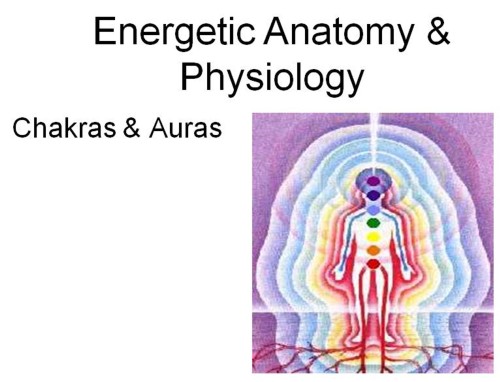
Aromatherapy
There’s some perfectly sensible stuff about the chemistry of essential oils. It’s when it comes to what they are good for that things rapidly come unstuck. Table 17 (extracted from a handout on essential oil chemistry) has all sorts of suggested uses
Energising
Essential oils can correct deficits or blockages in energy
Difficult to back up with scientific research, but nevertheless an important property in aromatherapy
Synergistic blending using the energetic approaches
So it is "important" but there is no evidence for it. The Table is prefaced by a disclaimer of sorts.
There is a body of anecdotal information concerning the potential therapeutic actions of essential oils, such as their anti-inflammatory, sedative and analgesic effects (Bowles 2003).
Despite some of the potential uses of essential oils contained in Table 17, it is not the role of the aromatherapist to treat specific conditions such as infections. However, the therapist can include appropriate oils in a holistic context, and can offer aromatherapy support preparations for home use.
At this point the handout does give quite strong hints that there is no good evidence that any of it works. In that case, why are they doing a three year degree in it?
Then of course we get on to the 19th century vitalism (being taught in the 21st century) and the usual ‘energy’ nonsense. For example
Holmes (1997) proposed that the nature of a fragrance can bring about specific psychotherapeutic effects. Using three fragrance parameters – tone (odour quality), intensity and note (evaporation rate), with tone being the most significant, and six fragrance categories – spicy, sweet, lemony, green, woody and rooty. He proposes that the nature of a fragrance will bring about specific psychotherapeutic effects. The following is a summary of his suggestions.
‘High/Top tone’ oils such as those from the citrus group, the Myrtaceae family and also ylang ylang extra and 1, lavender and mimosa abs. will have a stimulating, uplifting effect.
‘Low/Base tone’ oils including vetivert, patchouli, sandalwood and also tuberose, hay and oakmoss abs., will have a depressing, sedating effect.
Gabriel Mojay is quoted as saying
“Fragrance is the primary effective quality of essential oils. By this we mean their most immediate and generalised effect on the body and mind. This effect is first and foremost an energetic effect – as it is the vital energy of the human organism that first responds to an essential oil and its fragrance.”
These are just more empty words, woolly thoughts about long-discredited ideas of vitalism. They are presented entirely uncritically.
Reflexology
Reflexology is based on the utterly barmy proposition that "… reflexologists claim to be a system of zones and reflex areas that they say reflect an image of the body on the feet and hands, with the premise that such work effects a physical change to the body".
Regardless of its absurd premises, it just doesn’t work. A review by Ernst (2009) concludes
"The best evidence available to date does not demonstrate convincingly that reflexology is an effective treatment for any medical condition."
It is simply a foot massage, There’s nothing wrong with that, if you like that kind of thing, but please don’t pretend it is anything more
One handout lists, under the treatments for Migraines and Headaches
- Homeopathy (applying the principle of similimum)
- Herbal
- Massage for relaxation
- Reflexology (addressing reflexes relating to head, neck, solar plexus, spine, pituitary & digestive systems).
- Nutritional therapy
- Accupressure.[sic]
- Bach Flowers may be useful
No evidence is cited for any of them, not doubt because next-to-none exists.
A three year degree in rubbing feet is just an absurdity.
The material that was sent about reflexology was very thin. I’ve asked for more, but in a sense it doesn’t matter, because all one has to do is look at a standard reflexology diagram to see what a load of unmitigated nonsense it is. There isn’t the slightest reason to think that an area on your big toe is ‘connected’ in some unspecified sense, to you nose, It is just preposterous made-up junk.

Diagram from Scienceblogs
Who is responsible?
I’m quite happy to believe that the people who teach this new-age nonsense actually believe it.
|
What I would like to know is whether the Principal and Vice-Chancellor of Edinburgh Napier University believes it. She is Professor Dame Joan K. Stringer DBE, BA (Hons) CertEd PhD CCMI FRSA FRSE. That’s an impressive string of initials for somebody who seems to defend 19th century vitalism as a suitable subject for an honours degree. I could ask her, but such letters rarely get a response. |
Follow-up
I hate to be forced to return to the world’s most boring delusion, homeopathy. It is boring because the battle to inform people how daft it is has been almost won. Now not a single Bachelors degree in homeopathy appears in UCAS, compared with at least five in 2007. But the battle is not quite won with the UK Government. This post is not so much about homeopathy as about the failures of the Government and the MHRA.
The Medicines and Health Regulatory Authority (MHRA), has just launched yet another consultation and I have felt obliged to waste an entire Sunday writing a response to it, I can’t imagine that any scientist would disagree much with what I have written, but most of them have far better ways to spend their time than bothering about the lunatic fringes of medicine. No doubt most of the responses will come from people who make money from homeopathy, Not just the homeopaths on the High Street, but also the very rich companies like Boiron and Weleda who make enormous profits from selling pills that contain nothing but a bit of sugar.
The documents
The consultation concerns what should be done, about homeopathy in the wake of the scarifying report of the House of Commons Select Committee [get pdf], and the governments response to that report [get pdf].
The MHRA’s request for consultation is here. Download the consultation document. You can download my full response [get pdf], Please write your own response and send it to andreafarmer@mhra.gsi.gov.uk before February 17th. Feel free to plagiarise anything you find here.
Another good response is from Healthwatch, [download pdf]
And an excellent response by Prof John C. McLachlan [download pdf].
Now I’ll filll in some of the background and outline why I think the MHRA still hasn’t understood.
The Medicines Act 1968 and PLRs
The Medicines Act (1968) was passed in the wake of the thalidomide disaster. It required evidence that medicines work and that they are safe. It was not possible to check all existing medicines by the time the Act was implemented in 1971, so, as a temporary measure, many medicines, including homeopathic stuff, were give a "public licence of right" (PLR). Forty years later they have mostly vanished. But not for homeopathy. The PLR is the licence that allows homeopaths to break all the rules. They still exist.
MHRA cocked it up in 2006
The story starts with the National Regulation Scheme for homeopathic junk that was introduced by the MHRA in 2006. This allowed, for the first time, indications to be put on the labels of the bottles of sugar pills. There were howls of outrage from just about every scientific organisation (the medical establishment was, as usual, more pusillanimous, with some honourable exceptions). The history is related here in the following posts.
The MHRA breaks its founding principle: it is an intellectual disgrace
The Royal Society speaks out on CAM
Learned Societies speak out against CAM, and the MHRA
The MHRA loses the plot: it allows mislabelling of Arnica gel
House of Lords slams homeopathy and the MHRA
MHRA admits herbal medicines unproven
The Science and Technology Select Committee report
This was an admirable effort, It extracted, with some difficulty, admissions from Boots’ professional standards director that the sold pills while knowing that they didn’t work. It also squeezed out of the then Health Minister, Mike O’Brien an admission that they don’t work, Less surprisingly, the head of the MHRA agreed that they don’t work. So it is unanimous (apart, of course, from those who make money from selling things that don’t work).
If you want to know more about Boots’ Professional standards, take a look at Mis-education at Boots the Chemist, or The Vitamin B scam. Don’t trust Boots, or Boots reaches new level of dishonesty with CoQ10 promotion, to name but a few. The oral sessions of the committee were notable for the squirming evasiveness of most of the answers to simple questions. An account can be found in Comedy gold in parliament and tragedy from Prince of Wales: editorial in British Medical Journal
The Government’s response to the report was mostly as truly pathetic bit of official waffle, like those letters you get when you write to your Member of Parliament. But it did contain one good thing."In order for the public to make informed choices, it is therefore vitally important that the scientific evidence base for homeopathy is clearly explained and available." (though even that statement is attributed to John Beddington, the Government’s Chief Scientific advisor, rather than something the Government thinks essential).
"“The MHRA will review the labelling requirements under the NRS to ensure that these deliver clarity as to the status of products and their composition."
The proposals in the MHRA Consultation document’
There are a couple of good things in the proposals. The MHRA proposes to end PLRs (decades overdue, but nonetheless welcome).
The MHRA proposes to stop ‘regulating’ (ho ho) “Bach Flower Remedies” as medicines (but seems happy to classify them as food Supplements, another weasel description to evade sensible regulation). That’s sensible because they aren’t medicines. Homeopathic pills most certainly aren’t medicines either but the MHRA seems to have difficulty grasping that, and wants to treat them quite differently from “Flower remedies”
More honest labelling was about the only sensible thing recommended by the Government’s response. On this topic the MHRA proposals verge on the laughable
At present the labelling allowed under the NRS includes
“A homeopathic medicinal product used within the homeopathic tradition for the symptomatic relief of ….”
It is proposed to change this to
“A homeopathic medicinal product licensed only on the basis of safety, quality and use within the homeopathic tradition”
“A homeopathic medicinal product used within the homeopathic tradition for the symptomatic relief of……”
Spot the difference!
The is utterly inadequate. In fact it verges on the pathetic (and on the dishonest). Here is an extract from my full response.
"Sad to say these proposals to remedy the labelling problem are wholly inadequate. They are almost as deceptive as the originals. These labels don‘t come anywhere near to fulfilling the requirement in the government‘s response which said
In order for the public to make informed choices, it is therefore vitally important that the scientific evidence base for homeopathy is clearly explained and available
Why, oh why, cannot the MHRA bring itself to simply tell the truth? It seems to be so stifled by some perversion of political correctness that it is unable to do what it must know is right.
Nothing indicates more clearly the ludicrous state of the NRS than the label approved for Arnica 30C pills.
The approved label says
"ACTIVE INGREDIENT
Each pill contains 30C Arnica Montana
Also contains: lactose and sucrose"
The MHRA must decide whether or not it believes Avogadro‘s number or not.
How many people in the general public realise the ―Each pill contains 30C Arnica Montana‖ means that the ―pills contain no Arnica whatsoever‖? The very mention of the words ―active ingredient‖ will suggest to most people that there is an active ingredient when there is not. This wording alone is both dishonest and deceptive.
The rest of the approved label consists largely of make-believe too.
"If you are pregnant or breastfeeding consult your doctor before use"
What is your doctor meant to advise you about the dangers of taking a few mg of sugar when you are pregnant?
"If you take too much of the product (overdose) speak to a doctor / pharmacist and take this label with you,."
Unless the MHRA has disavowed Avogadro‘s number, an overdose is impossible. To allow a label like this makes the MHRA a laughing stock
https://www.dcscience.net/wp-admin/edit-tags.php?taxonomy=category
Labels should tell the truth in plain language. For example they should say
This product contains no Arnica
There is no evidence that it works for any condition, other than as a placebo
Some comments on regulation of magic medicine
Governments like to regulate things. They should have regulated the banks a bit more. The problem arises when you try to regulate things that are myths. Like homeopathy.
Andy Lewis has recently written a superb account of the problems on his Quackometer blog, When the Regulator Believes in Fairies, Who Protects the Public?
The government appears to believe that "training" will solve all the problems. Training people to believe things that aren’t true can never solve problems. On the contrary, it creates problems. Organisations like the Complementary and Natural Health Care Council (CNHC)do nothing to protect the public, They endanger the public (see Why the CNHC can’t succeed). Their excuse for rejecting complaints that members were making false claims was not to deny that the claims were false, but to say that it didn’t matter because that is what they had been trained to say. That is make-believe regulation.
Follow-up
.This is Andy Lewis’s version of an honest label. It looks quite accurate to me.

27 January 2011
News today makes one despair of the morality of governments. Remember those obviously fraudulent bomb detectors, no more than a dowsing rod? Although they are now the subject of a fraud investigation, they are still being sold. The government has banned their export to Iraq and Afghanistan, but NOT to anywhere else, This suggests not only that the government is (or at least was) quite happy to believe in dowsing. It also implies that even when they realise that it’s fraud they take the view that that business is far more important than even the most basic morality. No doubt they will allow fraudulent labelling of medicines in order to protect the homeopathic industry
Does politics have to be quite so disgusting?
28 January 2011. An excellent post on a similar topic is that referred to in a comment below. The MHRA and the non-regulation of homeopathy explains the European background better that I have done.
11 February 2011. Here is a characteristically beautiful response to the consultation by Prof John C. McLachlan, who has allowed me to post it here [download pdf].
Times Higher Education published today a version of an earlier post on this blog, Why should a postman pay for your university education?.
Although the submtted version was within length, it got shortened and, worse, a bit garbled in places. I got no chance to check the final version. The penultimate paragraph was not written by me. So here, for the record, is what I sent them.
|
.We hear a lot about lifelong education, and a good thing too. But we have a government that seems to think socially-useful learning does end at 18. This age is a watershed in official attitudes to education particularly in two areas, religious discrimination and education as a public good. In 1871 the Universities Tests Act made it illegal for a university to discriminate among applicants on the basis of religious beliefs (or lack thereof) and forced Oxford, Cambridge, and Durham to follow in the footsteps of UCL. For the last 140 years it has been unimaginable that any university would allow religious discrimination. In stark contrast, in 2010, religious discrimination (and the accompanying social discrimination) in entry to primary and secondary schools is not only legal, but is actively encouraged by the government. It was a trend that got worse while the ‘reverend’ Tony Blair was prime minister. The minister of education under the new conservative regime promised even more religious schools. Why the rules should be diametrically opposite when you are under 18 from when you are over 18 is baffling. It is equally baffling (and perhaps a partial explanation) that universities are not regarded as part of education at all by this government and its immediate predecessors. Universities are governed by the Department of Business, not the Department of Education. Education is not regarded as a continuum, or as a life-long project: it’s something you do at school. The government has managed the remarkable feat of devising a system for universities in which everybody loses. It saves the taxpayer little or no money (according to HEPI). It leaves universities worse off. And it does both of these while tripling the debt incurred by students. It’s hard to believe that such monumental ineptitude has motives that are other than ideological. The virtual privatisation of post-18 teaching, particularly of humanities, was a step too far even for Margaret Thatcher. The only too brief debate on these changes focussed almost entirely on how to repay an enormous debt. That was the wrong starting point. The first thing that should have been decided was what sort of university system we want. It is arguable that the honours degree system is quite unsuited to an age when half the population get higher education. A general first degree, at a teaching-only institution, would be much cheaper, and it would be a social leveller. If that were followed, for those who wanted and merited it, by a properly taught graduate school (as opposed to the present powerpoint-teaching charades), and this was taught by active researchers at research intensive places, the standard of education would be increased. There might be some problems with such a system, but they were not even discussed before rushing the changes through. The organisation that should have been at the forefront of fresh thinking, UUK, was paralysed as the elite VCs, all in favour of maximum fees, wrangled with the post-1992 VCs who saw themselves at greater risk. The result was total inaction. They may have been on leadership courses, but they failed to lead. The elite VCs are now finding that even £9000 will leave them worse off than before. They really should have thought a bit more about how to adapt to tertiary education for half the population rather than trying to fund things as they are at the moment. Whatever the system, the question will always arise: why should a postman pay for your university education? My answer is that they should pay, but not very much. They should pay because, although they may not get any direct benefit themselves, their children certainly may. The fairest, most progressive, tax is income tax. If you are a postman, or indeed a graduate, on a low income, you shouldn’t pay much tax, so you won’t pay much for other people’s university education. I can see no reason for the sudden change in attitude to, and funding of, education that happens when you reach 18. I see every reason why kids should be angry. I doubt that we have seen the last of the riots. I hope not anyway. |
Follow-up
|
One of my greatest scientific heros is A.V.Hill, and its one of my great regrets that I saw him only in the distance. He’s a hero partly because of his science, but also because of his other interests, in particular his efforts to help scientists escape from pre-war Germany. Read the Biographical Memoir of Hill, written by Bernard Katz [download pdf], and comments in my obituary for Katz.
A.V. Hill, c. 1935 (drawn by Edward Halliday in 1978, from a photograph) |
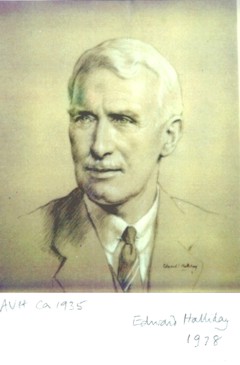 |
There are some amazing pictures from Hill’s photo album here. And you can read an account of a visit to the lab on Boxing Day 1960 written by AV’s grandson, Nicholas Humphrey (his father, John Humphrey, was external examiner of my PhD). And Tom Chivers, who writes a rather good column in the Telegraph is Alison Hill’s son, and so he’s the great grandson of AV. In yet another irrelevant coincidence, I lived for a year in a Max Planck Institute house that had previously been occupied by Otto Meyerhof who, in 1922, got the Nobel prize jointly with AV Hill.
Some of the scientific background is given by Austin Elliott, as I did in The quantitative analysis of drug–receptor interactions: a short history.
This post was prompted not so much by the science as by the curious conjunction of the New Year’s Honours List, and a discovery from Twitter. Hill won the Nobel prize for Physiology or Medicine in 1922, but refused the customary knighthood or peerage that gets offered on such occasions. Dr Alison Hill, AV’s granddaughter, mentioned on Twitter that Hill loved quoting a verse by A.A. Milne (author of Winnie the Pooh) that I had never heard before. It appears to come from a book, The Sunny Side, that Milne publshed in 1921. It’s worth quoting in full.
|
O.B.E. I know a Captain of Industry, I know a Lady of Pedigree, I know a fellow of twenty-three, I had a friend; a friend, and he |
This also led to the unexpected discovery that A.A. Milne, like A.V. Hill, had done a mathematics degree at Trinity College Cambridge before moving on to teddy bears.
Wikepedia gives a list of the alternative roll of honour, those who have declined an honour.
The list of honours in Higher Education contains the usual administrators and vice-chancellors. It contains next to no scientists. I can’t say i find it very inspiring. The main effect of the honours system seems to be to keep people from rocking the boat until the day they die.
One is once again reminded of the definition from A Sceptic’s Medical Dictionary (BMJ publishing, 1997). by Michael O’Donnell.
Knight starvation
“Affective disorder that afflicts senior doctors . . . A progressive condition that deteriorates with the publication of each Honours List and, in longstanding cases, can produce serious erosion of judgement and integrity.”
Here’s a 1932 picture with several scientific heros. Hill is in the centre, with A.J. Clark on his left and Verney on his right, J.H.Gaddum is on the left end of the back row (all holders of the UCL chair in Pharmacology). .
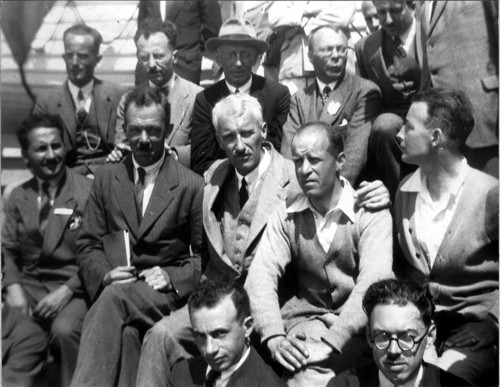
Taken from K J Franklin’s History of the International Physiological Congress – it is a photo taken on the SS Minnekhda, charted by European physiologists to attend the 1932 Boston congress. [Dr Tilli Tansey, FMedSci., Hon FRCP.,Historian of Modern Medical Sciences Wellcome Trust Centre for the History of Medicine, UCL
Follow-up
Here are two more documents that are relevant to the life of A.V. Hill.
Gerta Vrbová (born 1926, in Slovakia) wrote "Archibald V. Hill’s contribution to science and society" [download pdf]. She herself lived through the holocaust. The story of her escape to England is like an adventure novel. She became a professor at UCL where I met her many times.
" as an academic she was able to gain permission to travel between the Soviet states of Eastern Europe, and on a visit to a conference in Poland in 1958, she decided to make her escape. Travelling on foot across the mountains back to Czechoslovakia, she collected her children aged four and six, crossed the Polish Czechoslovak border with them and took a train to Warsaw. Having unofficially entered the names of children on her passport, she was able to obtain a transit visa for Copenhagen, from where, after a year, she was able finally to come to England." [from UCL news]

Gerta Vrbová in 2014, and with husband, Rudolf Vrba, in Bratislava after the war [picture from Daily Mirror]
There is another interview with Vrbová in the Physiological Society’s Oral History series.
A.V. Hill and alphabetical order of authors
In the first 50 years of its existence, the Journal of Physiology allowed authors to choose the order in which authors appeared, But for 60 years, from the 1930s to the 1990s, the journal insisted that authors’ names be listed in alphabetical order. That, for example, is why our 1985 paper is listed as Colquhoun & Sakmann. A.V.Hill was one of the people who proposed this system and a history of it has appeared recently [download pdf]. Personally, I liked this system. though having a name that begins the "C", I couldn’t be very active in advocating it. The alphabetical system worked well when authors did experiments themselves, and most papers had 1 – 3 authors. Nobody judges contributions based on author order for Hodgkin & Huxley, or for Katz & Miledi. In the 1990s, alphabetical order was abandoned. Too few other journals used that system, and it could not survive the era of guest authors that has accompanied the publish-or-perish regime imposed on academics by managers.
2 February 2017
A.V. Hill is one of my scientific heroes, because of his science, his humanity, his running (and because he turned down a knighthood after he got the Nobel Prize in 1922 -see above.
Hilda Bastian has written a timely article about him:The same folly,the same fury. It was posted shortly after Holocaust Memorial Day (27 January), the day on which Donald Trump chose to exclude from the USA all the refugees who are fleeing from the war in Syria.
AV Hill played a central role in helping German scientists escape from the Nazis -to the enormous benefit of UK science. He spoke from the same stage as Mussolini.
He said
“Freedom itself is again at stake… It is difficult to believe in progress, at least in decency and commonsense, when this can happen almost in a night in a previously civilised State… [W]e must ensure that the same folly, the same fury, does not occur elsewhere.” A.V. Hill (Nature, 1933).
The post doesn’t mention Trump, Farage or May. It doesn’t need to.
This is the third part of a series of guest posts on the curious Steiner Waldorf cult
The first part was The true nature of Steiner (Waldorf) education. Mystical barmpottery at taxpayers’ expense. Part 1
Part 2 was The Steiner Waldorf cult uses bait and switch to get state funding. Part 2
This post deals with the most contentious and serious aspect of Steiner schools, racism. It makes, in my view, a convincing argument that Steiner’s undoubtedly racist views remain a problem today. They can’t be dismissed simply by saying that Steiner was a child of his times.
This post was written by an ex-Steiner school parent, known on the web as @ThetisMercurio.
The essay supplies yet more reasons to think that Steiner schools are all based on pseudo science: Steiner’s Spiritual Science. It is important that we understand these schools because funding of these schools is imminent, through Michael Gove’s Free Schools policy.
Extracts from works by Olav Hammer and Peter Staudenmaier are included with the permission of the authors.
A Spiritual Elite
Our first two posts introduced Anthroposophy and our concerns about the state funding of Steiner Waldorf schools through the Free Schools policy. Anthroposophy, the belief system developed by Rudolf Steiner, undeniably underpins the pedagogy which informs teaching practice in Steiner schools. This is reflected in the course materials and recommended texts for Steiner trainee teachers, wherever these have been obtained.
|
What must be stressed is that an adherence to Anthroposophy and aspects of this pedagogy can lead teachers to make decisions about individual children based on race and disability, which many people would consider to be outright discrimination.
|
 Ceiling, First Goetheanum, Rudolf Steiner. Spirit worlds. |
This discrimination may be undeclared and subtle but we believe it is, when rightly understood, within the comprehension and scope of the Equality Act 2010 as interpreted by the Equality and Human Rights Commission. Does the ideological drive towards Free Schools justify a breach in the rights of children not to be exposed to such potentially damaging practice?
In this post I write about the history of Anthroposophy, and how Steiner’s privileged status amongst adherents has obscured understanding of Steiner Waldorf education. Although I’ll focus on Steiner’s race doctrines, it’s important to understand that an anthroposophical belief in karma and reincarnation must have an impact on children with learning disabilities. Some of the most distressing personal accounts on parent forums have described an encounter with this particular aspect of Steiner’s dogma. Liz Ditz, a writer on education and learning disabilities, has the same concern with regard to Waldorf Charters in the US:
“Waldorf/Steiner [is] particularly pernicious for children with educational special needs such as dyslexia, ADHD, and autism. Because of the underlying beliefs in karma and reincarnation, teachers at Waldorf/Steiner tend to believe that such educational challenges are part of a child’s destiny to “work out”. The Waldorf/Steiner attitude does not satisfy US laws relative to educating students.”
Roger Rawlings indicates Steiner’s thinking on disability on Waldorf Watch and the UK site EASE online has an account of ‘karma in the classroom’ by a parent with a Steiner training. Swedish blogger Alicia Hamberg describes the University of Aberdeen’s programme on Rudolf Steiner’s curative pedagogy, which draws directly on Steiner’s clairvoyantly acquired ideas. This area demands greater investigation before English Steiner schools can be assumed to satisfy discrimination legislation regarding children with disabilities.
There is a determined lack of interest and comprehension about the nature of Anthroposophy amongst those responsible for overseeing the inspection of Steiner schools (Ofsted, which delegates to the SIS) and also amongst those who will make the decision to fund particular schools. It may appear too difficult. The structure of an esoteric belief system, with gradually imparted ‘knowledge’: impenetrable texts, study groups, a tradition of communicating certain information orally (a great deal isn’t written down) and a distrust of critical thinking, means that Steiner teachers themselves can be confused about the nature or real life implications of Steiner’s dogma, as well as largely ignorant of the Waldorf movement’s history. But there is an undeclared hierarchy of anthroposophical knowledge and influence within a Steiner school’s college of teachers; decisions about individual children are often steered by collegiate anthroposophical impulse. Obfuscation is deliberate: when explaining Anthroposophy, as far as the movement is concerned the answer depends on who is asking.
We can’t afford to be ignorant or to accept Steiner schools on their own terms. The history of Anthroposophy and thereby Steiner Waldorf education is essential reading. That history contains a warning, and we ignore this at our own risk.
Lessons on Spin from the New Schools Network
In November 2009, a meeting was held in London between representatives of the Steiner Waldorf Schools Fellowship and English Steiner Schools, including Emma Craigie, Rachel Wolf of the New Schools Network and Sam Freedman, Tory special advisor for education. It was called: ‘Moving forward, a special pre-election seminar about possible developments in the state funding opportunity for Steiner schools’.
A transcript of this seminar appeared online in March 2010 on both UK Anthroposophy and Liberal Conspiracy. I can reiterate that the transcript is a genuine account of a public meeting. No one present has to the best of our knowledge complained that this is not the case. Since there appears to be no attempt to dissuade from pursuing Free Schools funding the Steiner schools and initiatives mentioned in our second post (in fact many more than three of these schools are well advanced) I believe it is important to revisit this seminar.
The NSN is already under scrutiny. After an intervention by Lisa Nandy, Labour MP for Wigan, it has been the recipient of regulatory advice from the Charity Commission regarding its responsibilities as an independent charity. The clarity of NSN funding arrangements has also been questioned. I suggest that if Rachel Wolf is expected to advise parents on the best way to educate their children, she cannot afford, in the case of 18 or more potential Steiner Free Schools, to ignore these two salient problems in the path of state funded Steiner education:
1) Accounts from parents who are or who have been unhappy with the Steiner schooling system and those who have had negative experiences associated with the schools.
and
2) The writings of Rudolf Steiner and Anthroposophy
I agree with those at the seminar that the latter will be the greater problem. In fact, I assert that it’s an insurmountable one, or at least that it should be. This can’t be cured by good PR or by changing a name. Should the success of the Free Schools policy need to be bolstered by protecting Steiner Waldorf’s reputation from disenchanted parents, students and teachers, it will mean a concerted effort to ensure their voices are not heard or their stories are discredited. Such a tactic would be unsustainable, to put it mildly.
In the seminar, it was mentioned that there are racist aspects to Steiner’s writings. This accusation is far from new and it seems it was no surprise to those present. If Sam Freedman is aware of a potential threat to the reputation of the state from the funding of Steiner schools with an adherence to ‘Steiner says’, (an adherence which troubled the writers of the 2005 Woods report) he should be concerned that since the closure of the University of Plymouth Steiner BA there are no publicly accountable Steiner Waldorf teacher training courses in the UK. It’s unclear where the teachers are going to come from, especially since it appears there will be no requirement for Free Schools teachers to be formally trained. British Steiner Waldorf training will be essentially ‘in-house’ (perhaps at the Steiner Academy Hereford).
The issue of whether racism exists as an active agent within Anthroposophy was not addressed seriously at the pre-election meeting, although anthroposophical distinctions regarding both race and disability have human consequences and political implications.

Steiner’s drawing of the “evolution of humankind” through the various stages – Hyperborea, Lemuria, Atlantis — from lower to higher forms (fish to reptiles to mammals etc), with the top three categories marked “apes,” then (American) “Indians,” then at the very top “Aryans.” Steiner’s 1907 lecture refers to both apes and Indians as “decadent side branches” of evolution.
Rudolf Steiner, 1907. Menschheitsentwickelung und Christus-Erkenntnis (Dornach: Rudolf Steiner Verlag, 1981)
Pervasive racial assumptions run throughout Rudolf Steiner’s work. Anthroposophy itself is : “built around a racial view of human nature arranged in a hierarchical framework,” and Steiner’s doctrine awards a higher or lower place in the spiritual evolution of mankind for certain races, with their attendant characteristics. If Freedman believes the schools can simply not teach what Steiner said, he shows a fundamental misunderstanding of the nature of Anthroposophy, and of its role within Steiner schools. Anthroposophy is not taught to the children: it informs the pedagogy. It is taught to the teachers. But since it is an esoteric religion, with hidden knowledge, that teaching is often opaque. In addition, Anthroposophy is not a tradition in which critical thinking is prized, indeed the intellectual is suspect; Steiner’s spiritual science has its own, privileged internal logic and route to acuity. As Olav Hammer, a Professor of the history of religions, comments in his accessible book ‘Claiming Knowledge’:
“..anthroposophy has an overtly formulated epistemology, which claims rational status for its visionary means of attaining knowledge.”
Hammer explains:
“For the anthroposophist, spiritual science is as inexorably logical as the natural sciences. The path towards attaining knowledge of the higher worlds, including insights into the exact mechanisms of reincarnation, lie open to those who practice the methods of Geisteswissenschaft [spiritual science] to the full. It is not only part of Steiner’s experience, but also potentially part of the experience of every individual. A carefully outlined series of meditative exercises describes how one can attain knowledge of the spiritual truths.”
and the system is itself insulated from critique:
“Steiner frees himself from the need for empirical investigation by claiming the ability to clairvoyantly access the Akashic record. In the Akashic record, Steiner found innumerable specific details on the workings of the cosmos and the human being, all presented as empirical facts.”
Hammer notes that Steiner’s method of spiritual science may appear democratic but is in reality autocratic. The only truly authentic insights are Steiner’s.
For those who believe they are developing clairvoyant faculties in pursuit of Anthroposophy’s Higher Worlds; Steiner’s racist doctrines, existing within an anthroposophical structure of reincarnation and karma, can be seen as essentially benevolent and redemptive. Though adherence (and awareness) certainly differs amongst teachers, it is impossible to remove Anthroposophy from the Steiner school pedagogy, from the required reading on the teacher training courses, from the mission of the schools. It would be entirely naive to imagine anthroposophical allegiances and beliefs in Steiner Free Schools could be policed by the DfE, especially as British courses disappear from public view or teachers are trained in other countries. Nor can the public be shielded from evidence of Anthroposophy’s precise nature and history.
Anthroposophy, and consequently the Steiner Waldorf movement, resist external critical analysis. The occult has until fairly recently been largely ignored by serious academics, and those who have explored Theosophy and other esoteric movements have been generally sympathetic to the possibility of supernatural agency. But, as we’ve seen with Olav Hammer as example, this has changed. There is now extensive academic research into the foundations of Anthroposophy and the development of Steiner Waldorf schools, enabling a non-arcane understanding of anthroposophical texts. Much of this is of course in German, including Helmut Zander’s 2007 two volume study, ‘Anthroposophie in Deutschland’.
Zander describes the ad hoc nature of the first Waldorf school, as Steiner borrowed much from already existing educational reform movements as well as from traditional models, and added his own spiritual insights. The results could only in some areas be thought of as progressive: the schools were co-educational and did not focus on exams. But from the beginning, the Waldorf system was teacher-led, not child-led and had strong authoritarian tendencies.

Rudolf Steiner 1861-1925 – Spiritual Insights
Most importantly, Zander contextualizes Steiner as a historical figure, without needing to pass judgements on the accuracy of his supernatural claims. He focuses on the political landscape in which Steiner existed in real, not occult terms. And he demonstrates the significant role of Steiner’s race theories within his work, noting how anthroposophical race doctrine frequently involves implicit or explicit value judgements. Even though Zander encourages dialogue with anthroposophists who can tolerate some kind of external analysis, an extreme voice still demanded Zander’s university revoke his degree, on the grounds that he couldn’t determine the validity of any of Steiner’s claims without himself attaining ‘knowledge of the higher worlds’. Crazy as this sounds, it’s the singular manifestation of a familiar anthroposophical motif, a demand that Anthroposophy be understood – and respected, exclusively on its own terms.
Rudolf Steiner and race: the path toward the universal human
One of the most authoritative writers about Anthroposophy in English is American historian Peter Staudenmaier. His recent PhD in modern history, written at Cornell, concerns Anthroposophy in Germany and Italy from 1900 to 1945. A fluent German speaker, Staudenmaier had access to Steiner’s untranslated work as well as to original archive material. He stresses that Steiner’s prolific output can be internally contradictory, enabling supporters to claim that anthroposophical race doctrine is incidental or misunderstood. But nevertheless, there’s a dominant and explicable theme, owing much to Steiner’s occult interpretation of German nationalism. Steiner’s attitude to Jewishness is an example of insular preoccupations:
“The nature of Steiner’s hostility to Jewishness was thus both ordinary and anomalous; it incorporated the common misconceptions of the era and simultaneously transcended these within the peculiar framework of “occult science”. It was not so much hatred or fear of Jews that animated Steiner’s mature antisemitism, but ignorance of contemporary Jewish life, of modern Jewish culture and history, as well as a myopic commitment to German spiritual superiority. What Steiner did know about Judaism, moreover, was generally refracted through a Christian and Germanocentric lens.” Peter Staudenmaier ‘Rudolf Steiner and the Jewish Question’ Leo Baeck Inst. Yearbook 2005
Steiner’s claims to ‘spiritual science’ to an extent reflect an earlier association with zoologist and social Darwinist Ernst Haeckel. (Richard Dawkins comments in ‘The Greatest Show on Earth’ that Haeckel was “perhaps Darwin’s most devoted disciple in Germany” and while praising Haeckel’s draughtsmanship adds: “the devotion was not reciprocated”.).
|
Staudenmaier suggests a mutable concept of evolution may have mediated Steiner’s shift from ‘secular to sacred’, but that it was a conversion to Mme Blavatsky’s occult movement, Theosophy, that most inspired Steiner’s racial theories:
|
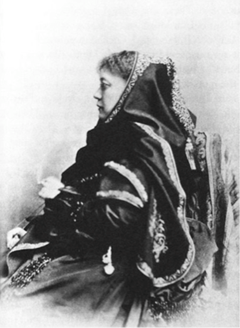 Madame Blavatsky: Theosophist and medium. |
“Steiner’s doctrine of racial evolution is more than a biological appendage to his spiritual cosmology. For Anthroposophy as for Theosophy, evolution is the link between the human and the divine, it is a process supervised by higher powers and a vehicle for the soul’s elevation and purification. [ ] The guiding thread throughout Steiner’s race mythology is the motif of a small, racially advanced group progressing into the next era while the great mass of backward populations declines. In the current era, the dominant race is the Aryan race, which evolved out of a small number of specially advanced colonists from Atlantis. In Steiner’s words: “Ever since the Atlantean Race began slowly to disappear, the great Aryan Race has been the dominant one on earth.”
There is a crucial difference for Steiner between ‘race development’ and ‘soul development’:
“The two must not be confused. A human soul can develop itself in such a way that it incarnates in a particular race within a given incarnation. If it acquires certain capacities in this incarnation, then in a later incarnation it can incarnate in a different race.”
Rudolf Steiner, Christus und die menschliche Seele [Christ and the human soul] (Dornach: Rudolf Steiner Verlag, 1997), 92
Staudenmaier elucidates:
“As the incarnating souls ‘became steadily better and better’, Steiner explained, ‘the souls eventually passed over into higher races, such that souls which had earlier been incarnated in completely subordinate races developed themselves upwards onto a higher level and were able to incarnate later into the physical descendants of the leading population of Europe’. Steiner further contended that the very existence of different racial groups on the Earth at the same time was a cosmic mistake, a detour from the proper route of humankind’s development. This claim was tied to Steiner’s vision of the eventual emergence of a ‘Universal Human’, the goal of his teleological conception of evolution. While pointing toward the ultimate disappearance of race as a meaningful factor in human existence, Steiner’s theory of the Universal Human is built around a contrast with ‘lower types of people,’ which constitute the necessary counterpart to the ‘uniform, perfect, beautiful type of human being,’ the cosmic goal that underlies ‘the meaning of our whole earthly evolution’.”
Though potentially spiritually ‘enlightened’ to the initiate, Steiner’s views on race remain reprehensible:
“The white population, then, represent normal human beings who continue to progress, while Asians and Africans are abnormal peoples who were not as capable of evolving. Statements like these can be found throughout Steiner’s works, and may reflect the prejudices prevalent among educated Europeans of his era. Perhaps the most instructive instances are Steiner’s various statements about black people. [ ] Addressing the first generation of Waldorf teachers in 1923, Steiner responded to a question about teaching French with the following remarks:
“The French are committing the terrible brutality of moving black people to Europe, but it works, in an even worse way, back on France. It has an enormous effect on the blood and the race and contributes considerably toward French decadence. The French as a race are reverting."
Peter Staudenmaier, Race and redemption: Racial and Ethnic Evolution in Rudolf Steiner’s Anthroposophy : Nova Religio 2008

All must have disclaimers
Returning to the seminar in London discussing Free Schools funding for Steiner Waldorf: Should Steiner schools engineer a more multi-cultural image? This strategy would cause embarrassment to a government facing the understandable fury of non-white Steiner parents who come across Steiner’s race doctrines – unless Rachel Wolf persuades Cornell to revoke Dr Staudenmaier’s PhD (with assistance from dedicated anthroposophical defenders). Waldorf’s biggest problem, acknowledged after the departure of Freedman and Wolf, is undoubtedly the teachers:
“It was felt that there may be some difficulty in making a blanket rebuttal of all Anthroposophy because many people throughout the Steiner schools system, especially teachers, strongly support many aspects of that belief system. If teachers were asked to make a blanket rebuttal of Anthroposophy, many of them may not do this.”
They cannot do this. For many, Anthroposophy is the point. Rudolf Steiner is considered by his followers to be irreproachable, a spiritual master blessed with clairvoyant powers. Pull the thread of the race doctrines out of the design, there is a corresponding pressure on Steiner’s doctrine of reincarnation and karma. The Steiner Waldorf pedagogy itself rests on anthroposophical dogma. Although a reappraisal of doctrine is not without precedent within religious movements, it would be especially problematic for Anthroposophy, as an esoteric belief system. Knowing this, the easiest way to protect the movement is to be pragmatic and to issue disclaimers. But these disclaimers bear analysis, since many anthroposophists still defend Steiner’s racial and ethnic teachings; believing them, as Staudenmaier explains, to be “humanitarian, tolerant, and enlightened.”
Here is the (current) disclaimer on racism from the Steiner Waldorf Schools Fellowship (SWSF).
|
Is it true that some of Rudolf Steiners writings and lectures contained statements that could be interpreted as racist? Yes. Even though Steiner’s ideas are based on a profound respect for the equality, individuality and shared humanity of all people, regardless of race or ethnic origin, his works do contain a small number of quotations that are discriminatory. The SWSF rejects these statements and all racism. However, it should be noted that other great thinkers of his time including Darwin, Schweitzer, Gandhi and Carl Jung also spoke of race in a way that offends modern sensibilities. This does not render them or their work ‘racist’. It is ironic that Steiner schools sometimes have to defend themselves against these accusations. Our schools thrive on every continent, in every culture and within a wide range of ethnic contexts. For example, during the period of the apartheid regime in South Africa, the only school catering for mixed races was a Steiner Waldorf school & today there are schools following Steiner philosophy of education in diverse cultures & communities, including: Israel, Egypt, Kenya, Sierra Leone, Taiwan, Japan, Brazil or Hawaii, over 60 countries in all. It should be noted that all the Steiner schools in the UK actively are opposed to all forms of discrimination against any person or group of people on the grounds of race, gender, faith, disability, age and sexual orientation and are committed to promoting equality of opportunity and reflecting the diversity of the children, staff and parents served by their school. Further clarification about this can be found on the Statements page of the European Council for Steiner Waldorf Education website (by clicking the ‘Waldorf schools against discrimination’ link). |
The first word is unusual, though the disclaimer’s tone betrays the movement’s haughty antipathy to external analysis – and frankly it’s simply untrue. There are a very large number of Steiner’s pronouncements which could not only be interpreted as racist, they are racist. Saying they are not racist costs the SWSF nothing and will not make them disappear. (To be candid, many of Steiner’s statements clearly discriminate between races in both an unpleasant and prosaic manner, the ‘spiritual’ is no excuse.)
But the statement reveals a significant misunderstanding of racism. It is historically naive to imagine that being represented in diverse cultures and communities can define a worldview. Catholic schools are similarly represented, this doesn’t alter the nature of Catholic teachings; Anthroposophy’s racial doctrines do not magically change because there are Steiner Waldorf schools in Kenya. The disclaimer also ignores the fact that South African Waldorf schools were founded by Max Stibbe (the Waldorf school in Pretoria is still named after him), a vocal supporter of apartheid. Peter Staudenmaier comments:
“[Stibbe] was also the editor of the Dutch Waldorf journal Ostara, as well as the founding editor of an even more influential Waldorf journal, Vrije Opvoedkunst, in 1933. Vrije Opvoedkunst is where Stibbe published his racist articles in the 1960s, which formed the basis for the "racial ethnography" courses in Dutch Waldorf schools well into the 1990s.”
Nor can the recent promotion of a non-white titular Vice Principal (at the state funded 315 pupil (£5.2 million) Hereford Steiner Academy cancel out Steiner’s racial doctrines.
In addition, under “What is Anthroposophy?’ the SWSF states:
“Like many inspiring thinkers from the past, Ghandi and Darwin being other examples, Rudolf Steiner provides us with important insights which continue to be relevant today, as well as statements which conflict with our contemporary understanding of inclusivity and equality.”
It’s extraordinary that in a description of Anthroposophy by the Steiner Waldorf movement’s umbrella organisation in the UK, there’s no mention of karma, reincarnation, higher worlds, spiritual science etc, or the fact that anthroposophists believe Steiner was clairvoyant. Zoologists do not believe Darwin was clairvoyant – nor did Darwin teach an occult racial doctrine. Steiner’s unique status amongst his followers means that he cannot be excused as simply ‘a man of his time’. Even so, such racial ideas were rejected by many of Steiner’s contemporaries.
From a historical perspective, racial remarks should not be assessed according to whether they offend modern sensibilities. What makes a particular text racist is its content, what it actually says about race.

The 2nd Goetheanum, designed by Steiner – world centre for Anthroposophy – Dornach, Switzerland
The European Council for Steiner Waldorf Education) disclaimer document ‘Waldorf schools against discrimination’, linked to by the SWSF, states:
“Anthroposophy, upon which Waldorf education is founded, stands firmly against all forms of racism and nationalism. Throughout Steiner’s work there is a consistent anti-racist sentiment and he frequently described racist views as being anachronistic and antithetical to basic human values and dignity. The Waldorf schools are aware, however, that occasional phrases in Rudolf Steiner’s complete works are not in concordance with this fundamental direction and have a discriminatory effect.”
This is extraordinarily mendacious, and only sustainable if no one else – specifically no politician – reads any Steiner. The ‘discriminatory effect’ is reflected in the actions and decisions of teachers in the classroom, behaving in accordance with anthroposophical dogma which they may not even believe is racist. It should not be confused with an accusation that Steiner Waldorf schools openly discriminate on grounds of race, for example at point of entry, which they do not. Whether Steiner’s teachings themselves are ‘discriminatory’ makes little sense in an early twentieth century context – what matters is that they are racist. A confusion between discrimination and racism further highlights the worrying anthroposophist misunderstanding of racism.
This ECSWE disclaimer is cited by the Rudolf Steiner school South Devon. This is one of three English Steiner schools nearing funding, with the support of the Tory MP for Totnes, Dr Sarah Wollaston. The school also seeks to distance itself from “any racism stated or implied in any of Rudolf Steiner’s speeches and writings (dating from the mid -1880s to his death in 1925)” It’s alarming to find this on a school website bearing the name of the seer in question. But the disclaimer doesn’t acknowledge any statements by Steiner, much less examine their racial content. There’s no explanation of why this statement needs to be there.
On the same ECSWE site there’s a link to a document called: ‘Overcoming Racism through Anthroposophy: Rudolf Steiner and Questions of Race’. This is an audacious title. Peter Staudenmaier responds (hyperlinks mine):
“Far from a denunciation of any and all racist statements made by Steiner, it is a defense of Steiner’s racial teachings. It also claims that Steiner opposed antisemitism throughout his life, that he was deeply opposed to any philosophy of racial or ethnic superiority, and so forth. The document is co-authored by Detlef Hardorp and Lorenzo Ravagli, among others, who have very vocally and quite explicitly defended a range of Steiner’s racist arguments. This remains the mainstream position for both the Waldorf movement and the broader anthroposophist movement today.
In my view, a perfunctory ‘denunciation’ of ‘any and all racist statements made by Steiner’ — even if we could find such a denunciation from some anthroposophist body or other — would miss the point. If anthroposophists want to face up the racist components in their ideological legacy, they need to analyze and understand what Steiner taught about race, not pre-emptorily denounce it, and they need to figure out how to revise the overall conceptual structure of anthroposophy, which in its current form is built to a significant extent around racial premises. Simply waving away the problem with a vague gesture of disassociation accomplishes nothing toward that end, indeed it actively hinders the steps that could lead toward that end.”
A 1998 report by Dutch anthroposophists concluded there were no ‘racist teachings’ in Rudolf Steiner’s work. Peter Staudenmaier believes that an attempt by anthroposophists to come to terms with Steiner’s race doctrines, the “Frankfurt Memorandum” 2008, is flawed partly by using that Dutch report as its inspiration.
Significantly, former Waldorf teacher Tom Mellett notes parallels between the Steiner movement’s denunciation of Steiner’s racism and statements made by the Catholic church regarding priestly sex abuse.
Race in the classroom
Anthroposophy impacts on real children. Ray Pereira noticed the racist overtones in his child’s ‘Steiner stream’ in an Australian school:
“Mr Pereira, who is from Sri Lanka, said his concerns about Steiner’s racist beliefs were realised when his children were not allowed to use black or brown crayons because they were “not pure”. He said Steiner teachers at the state-run school recommended they not immunise their children because it would lead to the `‘bestialisation of humans”.”
Two years ago, at an established English Steiner school now applying for Free Schools funding; a British couple were alarmed when their 12 year old daughter (who’d been at the school for a year) told them a German teacher had read out the word ‘nigger’ from a book of poems, a standard text in Steiner schools. The mother reports that the teacher did not agree with the children that this is a racist word, indeed it was her daughter who was punished for refusing to back down. As a foster parent for many years and a mentor for Kids’ Company, the mother concerned is used to dealing with challenging situations but the school’s response to this incident (amongst others) shocked her. The staff seemed not to take the family’s concerns seriously and delayed taking action. Looking online for information on Steiner schools’ policies regarding racism, the mother discovered that in the book ‘How to Know Higher Worlds’, by Rudolf Steiner, (an edition last published 2008, Anthroposophic Press) a book on which one of the school trustees was basing workshops, there is an account of ‘reincarnation through the races’:
“Peoples and races are after all, merely different developmental stages in our evolution toward a pure humanity. The more perfectly that individual members of that race or people express the pure, ideal human type – the more they have worked their way through from the physical and mortal to the super sensible and immortal realm – the “higher” this race or nation is.”
In a formal meeting with the school, the father, who is black, calmly read aloud a quote from Steiner which stated that: ‘the black man is the child of the races’. There was no response from those present, presumably the trustees convinced themselves it was outside the remit of the discussion. The couple were shown the school’s discrimination document. But they report that when they asked the school’s Education Coordinator if he believed in Steiner’s doctrine of the reincarnation of the soul through racial hierarchies, he reddened with anger and refused to answer.
This critical Steiner mother notes an obvious inconsistency. In reply to a trustee’s defence that individuals chose which bits of Steiner to believe:
“I asked her, how they could do that when Steiner received his knowledge clairvoyantly – if it all came from the spirit world surely it was all true? I also said I didn’t believe that’s where he got his knowledge, unless the spirit world itself is racist.”
The child involved is now at school elsewhere. Her family arranged for a racism awareness day to be conducted at the Steiner school; this is required of every educational setting.

A Steiner Waldorf classroom (from here)
In response to Waldorf supporters’ claims that their teachers are simply not capable of racism and that Steiner schools are both enlightened and benign, Peter Staudenmaier writes:
“Many forms of racist belief are not intentionally sinister, but are instead embedded in high-minded, benevolent, and compassionate orientations toward the world. It is this type of racist thought, whose historical heritage extends through the White Man’s Burden and many forms of paternalistic racial ideology, that may find a welcome home in some Waldorf schools and other anthroposophical contexts, where it can perpetuate its ideas about race under the banner of spiritual growth and wisdom. This kind of racist thinking spreads more readily precisely because it is not tied to consciously sinister intentions. Seeing through this kind of racism – which, furthermore, often has more widespread and more insidious effects on the real lives of real people than the intentionally sinister variety does – means paying attention to the background beliefs that animate a project like Waldorf, whether among its founding generation or today.”
Staudenmaier is a historian, not primarily a critic of Steiner Waldorf education. But a knowledge of the history of the anthroposophical movement is essential if we are to make any sense of the difficulties the schools face today:
“I would be pleased if my research provided an opportunity for Waldorf admirers to ponder this contentious history and take its lessons seriously. What is worrisome about the Waldorf movement’s continued failure to address anthroposophy’s racial legacy is not that Waldorf schools in the twenty-first century will start churning out little Hitler youths; what is worrisome is that Waldorf advocates and sympathizers may unknowingly help prepare the ideological groundwork for another unforeseen shift in the broader cultural terrain, in which notions of racial and ethnic superiority and inferiority could once again take on a spiritual significance that lends itself all too easily to practical implementation in a changed social and political context. For this reason among others, I strongly encourage those involved in Waldorf endeavors to take another look at the history of their movement and the doctrines at its core.”
There is a reprise of these themes in an insightful article by novelist Hari Kunzru.
If those concerned with Steiner Waldorf education read nothing else, they should read Peter Staudenmaier’s article “Anthroposophy and Ecofascism”. It is a compelling account of Anthroposophy’s history; essential reading, too important to ignore.
Like Peter Staudenmaier, I have an interest in progressive forms of education. Steiner Waldorf education, far from being progressive or democratic, is dogmatic, autocratic and anti-intellectual. The persuasive lobby for state funded Steiner schools in my opinion misrepresents Anthroposophy, there are no exceptional applications. It is this lack of honesty that causes most concern. Steiner schools have failed a particular responsibility to their clients, not shared by Church of England or Catholic schools, to explain at the beginning what is for most parents an unfamiliar world-view.
Most seriously, mindful of Steiner’s dogma of karma and the reincarnation of the human soul through the races: If genuine equalities impact assessments were conducted on these schools, in my view it is inconceivable that the implications for children from black and ethnic minorities, and those with learning difficulties, would permit the funding of Steiner education.

German children 1930s. Image from Black News Tribune
Postscript
Download a pdf file of Anthroposophy’s racial doctrines: explanation and examples by Dr Peter Staudenmaier.
Follow-up
The British Medical Journal for 10 December 2010 carried a real classic, Integrative medicine and the point of credulity (it is no longer behind pay wall).
The subtitle was
"So called integrative medicine should not be used as a way of smuggling alternative practices into rational medicine by way of lowered standards of critical thinking. Failure to detect an obvious hoax is not an encouraging sign "
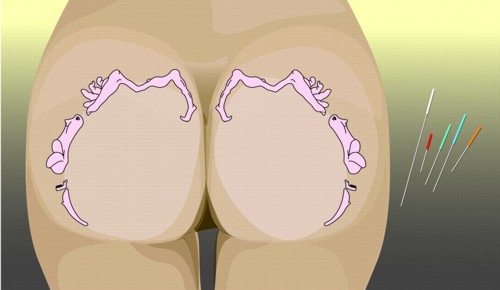
The use of the terms "integrated medicine" or "integrative medicine" as a form of bait and switch has been discussed quite a lot on this blog (e..g. here and here).
Two common reactions when reading about various sorts of magic medicine are "You couldn’t make it up" and "If you believe that you’ll believe anything". One way to test just how much a true believer will believe is the spoof paper. This was used to devastating effect by Alan Sokal, to demolish the pretentious nonsense of postmodernism.
John C. McLachlan of Durham University put the idea to the test, with hilarious results. He responded to one of those spam emails that invite you to speak at a conference, in this case “The Jerusalem Conference on Integrative Medicine.”.
"I have discovered a new version of reflexology, which identifies a homunculus represented in the human body, over the area of the buttocks. The homunculus is inverted, such that the head is represented in the inferior position, the left buttock corresponds to the right hand side of the body, and the lateral aspect is represented medially. As with reflexology, the “map” responds to needling, as in acupuncture"
"Unfortunately, this novel paradigm may meet with closed minds and automatic rejection. Patience and understanding of “closed” mindsets is essential in order to advance this new discovery in a way commensurate with its importance."
The helpful diagram (above) explained all. Unbelievably, he soon got an answer.
Dear Prof. John C. McLachlan,
You have sent a proposal to the The (sic) Jerusalem International Conference on Integrative Medicine. We are happy to inform you that the Scientific Committee has reached it’s (sic) decision and that your paper has been accepted and you will be able to present your lecture.
The scientific committee?
How did universities come to employ the sort of brain-dead people who could take something like this seriously? No doubt they have nice suits and ties, but lack something between the ears.
London South Bank University recently advertised at a salary £66,000 to £74,000 "London South Bank University is delighted to announce this new full time post of Professor of Integrated Health and Traditional Chinese Medicine". This makes a heartbreaking contrast to brilliant postdoctoral fellows on short insecure contracts, doing wondeful science for half that pay.
There is too much intellectual corruption in universities and vice-chancellors defend it rather than root it out, If the London South Bank school of quackery wants to save some money in the presnt financial crunch, it’s obvious where they should start. More details on this when they respond to my Freedom of Information requests.
Follow-up
We hear a lot about lifelong education, and a good thing too. But we have a government that seems to think life ends at 18. The contrast between official attitudes to schools and post-school education is striking. The contrast is most striking in two areas: religious discrimination and public support for costs.
Religous discriminatiion and selection
The Universities Tests Act was passed on 18 June 1871, while William Gladstone (Liberal) was Prime minister. It was "An Act to alter the law respecting Religious Tests in the Universities of Oxford, Cambridge, and Durham, and in the Halls and Colleges of those Universities". Of course UCL was founded in 1826, partly as a place that was free of religious discrimination. Since 1871 it has been illegal for a university to discriminate among applicants on the basis of their religious beliefs or lack of them. For the last 140 years it has been unimaginable that anyone would try to do such a thing.
In stark contrast, in 2010, religious discrimination among entrance to primary and secondary schools is not only legal, but is actively encouraged by the government. It was a trend that got worse while the ‘reverend’ Tony Blair (illiberal) was prime minister. The minister of education under the new conservative regime promised even more religious schools.
Why the rules should be diametrically opposite when you are younger than 18 from when you are over 18 is baffling.
It is equally baffling (and perhaps a partial explanation) that universities are not regarded by this government, or by Blair’s, as part of education at all. They are governed by the Department of Business, not the Department of Education.
Why should a postman pay for your university education?
I imagine that I’m not the only person who has wrestled with this question in the last few weeks (Stephen Law’s thoughts here)
In the UK it is a legal requirement to stay in full time education until the age of 16, and that should be increased to 18 by 2015. Although most children stay in school until 18, around 25% or 30% don’t. I have never heard anybody question the idea that education from 16 to 18 should not be supported 100 percent by the state, out of general taxation. That is the case despite the fact that not everybody stays in education up to 18.
Education up to the age of 18 is regarded as a common good and nobody questions for a moment that it should be free at the point of use.
Once again, everything changes entirely when you reach 18. Education is not regarded as a continuum, or as a life-long project. Suddenly at the age of 18, it stops being a public good worthy of state support, and becomes an optional extra for those who are rich, or those who are not deterred by the idea of going though life paying a debt that will, in some cases, approach the size of the mortgage on their house.
The ConDem coalition, on December 9th 2010, has come very close to privatising the teaching of humanities in universities. You are encouraged to learn languages from 16 – 18 and then these are dropped like a hot cake.
The result has been riots by schoolchildren and total discrediting of Liberal democrats who voted for one of the most philistine measures in living memory.
The discussion of this legislation has, in my view, focussed on the wrong thing. It has been almost entirely about the mechanisms for paying off an enormous debt. That was the wrong place to start. This is what should have been done.
(1) Consider what is being funded. Should the university system adapt to present circumstances, e.g by abolishing honours degrees and creating real graduate schools, as I suggested recently in the Times? Disgracefully, the government has rushed headlong into changes in funding without waiting to consider what it should be funding. Equally disgracefuly, Universities UK (the vice-chancellors’ trade union) has made no constructive suggestions for change, but appears to be rendered immobile by a rift between the Russell group VCs who want to grab as much as they can as soon as possible, and other VCs who fear for their existence.
(2) After deciding what form universities should have in the future, you can then go on to discuss how much public money should be used to support the system.
(3) Only after both of these have been done, does it make sense to talk about how you pay back any contribution made by the student (and that contribution should be, at most, no bigger than now).
In their haste to make people pay high fees, the government seems to have got the worst of both worlds. They have devised a scheme that, in the long run, is likely to cost the taxpayer as much as, or even more than, the present system, while at the same time trebling fees to students. It’s hard to imagine greater incompetence than that.
But the question still lurks: why should a postman pay for your university education? My answer is yes, but not much. They should pay because, although they may not get any direct benefit themselves, their children certainly may. The fairest, most progressive, tax is income tax. If you are a postman, or indeed a graduate, on a low income you shouldn’t pay much tax, so you won’t pay much for, inter alia, other people’s university education.
I can see no reason for the sudden change in attitude to, and funding of, education that happens when you reach 18.
I see every reason why kids should be angry. I doubt that we have seen the last of the riots.
I hope not anyway.
Follow-up
See also UCL’s Beautiful Occupation. Students seem to think more clearly about what’s happening than either university management or the government.
December 10 2010, The New York Times points out that tuition fees in the UK will, under this scheme, be double those of public universities in the USA."this new policy is an utter failure."
December 11 2010. An NHS doctor writes
"I was slightly dissapointed when 7/8 of my first year medical students showed up for their last day of teaching at my practice on thursday December 9th. The eighth student was ill, so not one of them was protesting. When I asked them why not they said that in their first week as medical students they were told not to get involved in any protests because even a police caution would mean they might be thrown off the course and almost certainly they wouldn’t get a job. Images of Fascist Spain or Nazi Germany came immediately to mind (I have just read Alone in Berlin)"
December 11 2010. The Guardian reports:
Liberal Democrat grassroots hit back over tuition fees
Richard Grayson, former director of policy, says Liberal Democrats should move closer to Ed Miliband and Labour
That sounds better.
December 12 2010. The Observer reports:
“Police officers ‘tried to stop hospital staff treating injured protester’ Mother of injured student Alfie Meadows said that her son’s life could have been put at risk by the journey to another hospital”.
Research quangos lead to mediocrity is the headline title of a letter to The Times appeared on 6 December 2010. It is reproduced below for those who can’t (or won’t) pay Rupert Murdoch to see it.
The letter is about the current buzzword, "research impact", a term that trips off the lips of every administrator and politician daily. Since much research is funded by the taxpayer, it seems reasonable to ask if it gives value for money. The best answer can be found in St Paul’s cathedral.
The plaque for Christopher Wren bears the epitaph
LECTOR, SI MONUMENTUM REQUIRIS, CIRCUMSPICE.
Reader, if you seek his memorial – look around you.
Much the same could be said for the impact of any science. Look at your refrigerator, your mobile phone, your computer, your central heating boiler, your house. Look at the X-ray machine and MRI machines in your hospital. Look at the aircraft that takes you on holiday. Look at your DVD player and laser surgery. Look, even, at the way you can turn a switch and light your room. Look at almost anything that you take for granted in your everyday life, They are all products of science; products, eventually, of the enlightenment.
BUT remember also that these wonderful products did not appear overnight. They evolved slowly over many decades or even centuries, and they evolved from work that, at the time, appeared to be mere idle curiosity. Electricity lies at the heart of everyday life. It took almost 200 years to get from Michael Faraday’s coils to your mobile phone. At the time, Faraday’s work seemed to politicians to be useless. Michael Faraday was made a fellow of the Royal Society in 1824.
. . . after Faraday was made a fellow of the Royal Society[,] the prime minister of the day asked what good this invention could be, and Faraday answered: “Why, Prime Minister, someday you can tax it.”
Whether this was really said is doubtful, but that hardly matters. It is the sort of remark made by politicians every day.
In May 2008, I read a review of ”The myths of Innovation” by Scott Berkun. The review seems to have vanished from the web, but I noted it in diary. These words should be framed on the wall of every politician and administrator. Here are some quotations.
“One myth that will disappoint most businesses is the idea that innovation can be managed. Actually, Berkun calls this one ‘Your boss knows more about innovation than you’. After all, he says, many people get their best ideas while they’re wandering in their bathrobes, filled coffee mug in hand, from the kitchen to their home PC on a day off rather than sitting in a cubicle in a suit during working hours. But professional managers can’t help it: their job is to control every variable as much as possible, and that includes innovation.”
“Creation is sloppy; discovery is messy; exploration is dangerous. What’s a manager to do?
The answer in general is to encourage curiosity and accept failure. Lots of failure.”
I commented at the time "What a pity that university managers are so far behind those of modern businesses. They seem to be totally incapable of understanding these simple truths. That is what happens when power is removed from people who know about research and put into the hands of lawyers, HR people, MBAs and failed researchers."
That is even more true two years later. The people who actually do research have been progressively disempowered. We are run by men in dark suits who mistake meetings for work. You have only to look at history to see that great discoveries arise from the curiosity of creative people, and that,. rarely, these ideas turn out to be of huge economic importance, many decades later.
The research impact plan, has been now renamed "Pathways to Impact". It means that scientists are being asked to explain the economic impact of their research before they have even got any results.
|
All that shows is how science is being run by dimwits who simply don’t understand how science works. This amounts to nothing less than being compelled to lie if you want any research funding. And, worse stiil, the pressure to lie comes not primarily from government, but from that curious breed of ex-scientists, failed scientists and non-scientists who control the Research Councils. |
 How much did RCUK pay for the silly logo? |
We are being run by people who would have told Michael Faraday to stop messing about with wires and coils and to do something really useful, like inventing better leather washers for steam pumps.
Welcome to the third division. Brought to you be Research Counclls and politicians.
Here is the letter in The Times. It is worded slightly more diplomatically than my commentary. but will, no doubt, have just as little effect. What would the signatories know about science? Several off them don’t even wear black suits.
|
Sir, The governance of UK academic research today is delegated to a quangocracy comprising 11 funding and research councils, and to an additional body – Research Councils UK. Ill considered changes over the past few decades have transformed what was arguably the world’s most creative academic sector into one often described nowadays as merely competitive. In their latest change, research councils introduce a new criterion for judging proposals – “Pathways to Impact” – against which individual researchers applying for funds must identify who might benefit from their proposed research and how they might benefit. Furthermore, the funding councils are planning to begin judging researchers’ departments in 2014 on the actual benefits achieved and to adjust their funding accordingly, thereby increasing pressure on researchers to deliver short-term benefits. However, we cannot understand why the quangocracy has ignored abundant evidence showing that the outcomes of high-quality research are impossible to predict. We are mindful of the need to justify investment in academic research, but “Pathways to Impact” focuses on the predictable, leads to mediocrity, and reduces returns to the taxpayer. In our opinion as experienced researchers, few if any of the 20th century’s great discoveries and their huge economic stimuli could have happened if a policy of focussing on attractive short-term benefits had applied because great discoveries are always unpredicted. We therefore have an acutely serious problem. Abolishing “Pathways to Impact” would not only save the expense of its burgeoning bureaucracy; it would also be a step towards liberating creativity and indicate that policy-makers have at last regained their capacity for world-class thinking. Donald W Braben John F Allen, Queen Mary, University of London; Adam Curtis, Glasgow University; Peter Lawrence FRS, University of Cambridge; David Ray, BioAstral Limited; Lewis Wolpert FRS, University College London; |
Now cheer yourself up by reading Captain Cook’s Grant Application.
Follow-up
Scientists should sign the petition to help humanities too. See the Humanities and Social Sciences Matter web site.
Nobel view. 1. Andre Geim’s speech at Nobel banquet, 2010
"Human progress has always been driven by a sense of adventure and unconventional thinking. But amidst calls for “bread and circuses”, these virtues are often forgotten for the sake of cautiousness and political correctness that now rule the world. And we sink deeper and deeper from democracy into a state of mediocrity and even idiocracy. If you need an example, look no further than at research funding by the European Commission."
Nobel view. 2. Ahmed Zewail won the 1999 Nobel Prize in Chemistry. He serves on Barack Obama’s Council of Advisors on Science and Technology. He wrote in Nature
“Beware the urge to direct research too closely, says Nobel laureate Ahmed Zewail. History teaches us the value of free scientific inquisitiveness.”
“I have emphasized that without solid investment in science education and a fundamental science base, nations will not acquire the ground-breaking knowledge required to make discoveries and innovations that will shape their future.”
“Preserving knowledge is easy. Transferring knowledge is also easy. But making new knowledge is neither easy nor profitable in the short term. Fundamental research proves profitable in the long run, and, as importantly, it is a force that enriches the culture of any society with reason and basic truth.”
How many more people have to say this before the Research Councils take some notice?
The press may like to portray students as irresponsible and revolting . When I visited the occupied Jeremy Bentham room last week, i got a very different impression. That was more than confirmed yesterday (29 November). The students aren’t just sitting around grumbling. They have organised a very impressive series of events. Here is yesterday’s programme.

|
I volunteered to discuss with them some ideas of what could be done to further their aims. It was the same day that our letter came out in the Daily Telegraph, that pointed out the foolishness of deciding on funding before deciding what form universities should have in the future, I also suggested some possible changes along the lines of those proposed in the Times in October. |
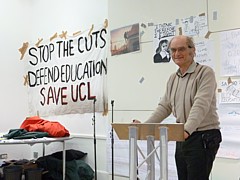 |
I didn’t talk for long and the discussion that followed was lively and constructive. It was about education, not revolt.
I was asked if I’d like to come back a bit later for group discussions, so I did. I found the students had split into groups. It could well have been an academic conference.
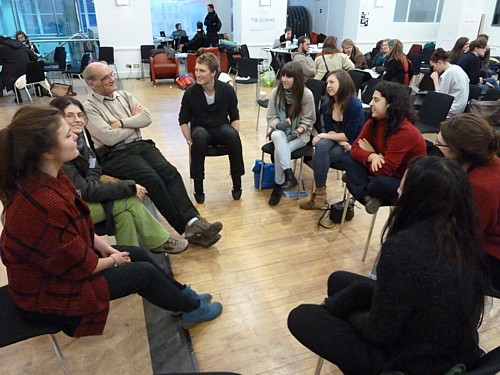
There was a cheerful but entirely serious discussion about what universities should be doing, about teaching methods and about research. There was also discussion about how the good atmosphere could be continued when the occupation eventually ends. Perhaps the most obvious thing is that the students were enjoying immensely being thrown together with people from other disciplines, whom they would never have met otherwise. There were two scientists in the group I joined, the rest being from a whole range of disciplines.
It is to the credit of UCL that they haven’t brought in bailiffs or cut off access to toilets. So a lot more sensible than Warwick university’s management for example. An email was shown on the screen from Rex Knight, vice provost (operations) who seems to have been put in charge of mediation. He’s the one who refused to do anything about it when HR were advertising for people trained in that curious form of psychobabble/pyramid selling scheme, neurolinguistic programming. He decined to meet the students. These days, you just can’t get the staff.
You can just walk in and out of the Jeremy Bentham room quite freely. Some students left for lectures and then returned. Others were away that afternoon on a demonstration outside TopShop on Oxford Street. If people like Top Shop owner Philip Green paid the taxes that they should do, the crisis might not be as bad as it is.
And between the earnest intellectual stuff they have fun too. This is the dance-off against the Oxford occupation.
And this is their weekend Ceilidh
Their blog is impressive. as is their organisation. They they have an events organiser with their own email address. You can follow the activities on Twitter @ucloccupation. In just a few days they have picked up more followers on Twitter than I have,
Even the BBC reporter, Sean Coughlan, sees this a something a bit different.
These are well-dressed, articulate youngsters, there’s no damage to the room, and the occupation leaflets are mixed up with sleeping bags and text books about biology and Spanish grammar.
This looks like a revolution that probably does the hoovering when it’s finished. Any stereotypes about rent-a-rioter are way off the mark.
,
It’s the Hogwarts kids, with their strong sense of right and wrong, who are now putting up the barricades.
And they seem as distant from the old left as they do from the new right.
This could be the best educational experience of the year for some of them, and they were making the most of it.
It is really rather beautiful.
Follow-up
Sad to say. UCL’s management soon managed to lose the moral high ground and went to court to evict the students. Their blog says
On Friday 3rd December two students on behalf of the UCL Occupations attended a hearing to resist the university’s application for a possession order. After almost an hour of legal debate, the judge acknowledged the occupying students’ rights to freedom of expression and freedom of assembly and concluded that no possession order could be granted without a full hearing of all the legal arguments. The hearing has been adjourned till Tuesday 7th December at 10:30am.
6 December 2010.Hobbled into work, for hospital appointment. The Slade School of Art is now occupied too. The signs are quite, eh, artistic.

One problem with the Browne report is that it didn’t consider the whole picture. It looked only at how to fund universities as they are now, and concluded that arts and humanities weren’t worth funding at all. What it failed to do (and to be fair, it wasn’t asked to do) was think what universities should be like. Perhaps that is just as well, given Browne’s views, but it means that the job is only half done.
I have argued that the present system, which was essentially dictated by John Major’s conservative government, is simply not working for an age when 45 percent of kids go into higher education. It makes no sense to decide on a funding mechanism before deciding what sort of university system we want.
Michael Collins is a lecturer in 20th Century history at UCL. On November 23rd he wrote a very interesting piece on the OpenDemocracy web site, Universities need reform – but the market is not the answer. He said
“As students begin a wave of occupations in university campuses across the UK, Michael Collins argues that academics should stand united in determined opposition to government cuts, but at the same time make a positive contribution to thinking about how the existing system of teaching and research can be reformed and restructured.”
His suggestions have much in common with mine, though mine were a bit more specific. I wrote about some concrete proposals in the Times Thunderer column. This is available without pay wall on this blog. (this was on October 11th, before the Browne report was published). .I immediately contacted Collins and we met on 25 November and the same day he published, again on OpenDemocracy, We need a Public Commission of Enquiry on the future of higher education. That was distilled into a letter and I spent most of the next day trying to get some support from scientists. A Saturday close to Christmas isn’t the best time to get responses to emails, but the result was satisfactory nonetheless.
On Monday 29th November the letter appeared in the Daily Telegraph
|
We need a Public Commission of Enquiry on the future of higher education It is clear from the scale of last week’s largely peaceful demonstrations across Britain that there is an enormous amount of concern amongst young people over the future of higher education. They are not alone. A wide range of commentators, politicians, public figures and academics have expressed closely argued reservations about the government’s attempt to rush through changes, the far-reaching consequences of which are so uncertain and potentially so damaging. Within universities there is considerable unease about what reforms based on the Browne report will mean. How might a ‘supply and demand’ model for arts and humanities funding function in practice? Education and research institutions cannot be set up, shut down and restarted according to market demand. With so much uncertainty about future employment prospects and economic conditions, student numbers will ebb and flow. Higher education needs greater stability. The Higher Education Policy Institute (HEPI) a respected independent think tank has pointed out that the government’s proposals for higher education funding “will increase public expenditure through this parliament and into the next”. The income stream from repayments which is supposed to form the long term basis for funding will not come back to the treasury for many years to come. This weakens the argument that planned changes to higher education funding are necessarily concurrent with a deficit reduction strategy in this parliament. The pledges on university tuition fees made at the 2010 general election mean the mandate for change is weak. We therefore do not believe that present circumstances are propitious for far reaching reforms. Instead, we propose the government set up a Public Commission of Enquiry, which should include wide consultations with politicians, academics, students, business leaders and others to examine the function and funding of higher education from first principles. Such an approach would be more likely to produce the consensus required to make reform deliverable and place the future of UK higher education on a sustainable footing. Sir Harold Kroto KCB FRS, Emeritus Professor of Chemistry, University of Sussex (Nobel Prize 1996) Sir Christopher Bayly FBA FRSL, Vere Harmsworth Professor of Imperial History, University of Cambridge Hermione Lee CBE FBA FRSL, Goldsmith’s Professor of English Literature, University of Oxford (1998-2008) John Dainton FRSA FRS, Sir James Chadwick Professor of Physics, University of Liverpool Christopher Pelling FBA, Regius Professor of Greek, University of Oxford Quentin Skinner FBA, Barber Beaumont Professor of the Humanities, University of London Linda Colley FBA, Shelby M.C. Davis 1958 Professor of History, Princeton University Jonathan Tennyson FRS, Massey Professor of Physics, University College London Christopher Wickham FBA, Chair of the Faculty of History, University of Oxford Richard Carwardine FBA, Rhodes Professor of American History, University of Oxford (2002-2009) Mary Beard FBA, Professor of Classics, University of Cambridge Steve Jones, Professor of Genetics, University College London Stefan Collini FBA, Professor of English Literature, University of Cambridge David Colquhoun FRS, Professor of Pharmacology, University College London Robert Gildea FBA, Professor of Modern History, University of Oxford J. N. Adams FBA, Emeritus Fellow, All Souls College, University of Oxford |
The letter in the Telegraph was accompanied by a front page story (despite competition from Wikileaks and the snow).

For a Tory newspaper, it was surprisingly sympathetic.
Meanwhile, the student occupations continue. More of that in the next post.
Follow-up
As I walked back from lunch today, I passed an exhibit that advertised the UCL Haiti Development Project. It was good to see that somebody still cares.
Now the dire problems of Haitians have got worse, At least 500 people have been killed by cholera.
In stark contrast, I also had today another email form Kate Birch. She used to be vice-president of the North American Society of Homeopaths (NASH), though she now appears to be only a “registered teacher”. I wrote twice about Kate Birch in 2007
In August, Homeopathic “cures” for malaria: a wicked scam
and in October, A visit from Kate Birch.
When I googled "Kate Birch" homeopathy I was surprised to see that these two posts came in 2nd and 1st position respectively. Since then, she has emailed me from time to time. Such is her delusion that she seems to think that she’ll be able to persuade me sugar pills cure malaria, rabies, smallpox, anthrax and plage, as claimed in her book.
Largely as a result of her letters, she appeared again in June 2009, in Homeopathy Awareness Week. Like tobacco companies, discredited at home, homeopaths exploit poor countries. And again in March 2010, More homeopathic killing
Today’s first email from Ms Birch was brief.
|
Subject: homeoapthy in haiti http://www.myfoxny.com/dpp/good_day_ny/haiti-earthquake-recovery-update-20101116 oh my god look what is happening now!!! those homeopaths are actually helping people in Haiti, and the nurses and doctors are learning how to do it. Kate Birch, RSHom(NA), CCH, CMT |
My reply was equally brief
"Fascinating. Are you saying that homeopathy can cure cholera?
David"
Her response, though entirely predictable on past form. is worth posting in full.
|
During the cholera epidemics of Paris in the mid 1800’s Hahnemann cured many patients with three remedies: Camphora, Veratrum and Cuprum. His son Friedrick Hahnemann came to America in the mid 1800’s and cured many cased in the 1840’s and 1890’s epidemics on the east coast and in the work camps for building the railway with the remedy Crotalus horidus when the cholera developed in to the stage with hemorrhages from all of the orifices. Of cousre repid hydration is necessary too, but homeopathy helps along the way and can act preventatively, in addition to proper sanitation. If you were to look in my book that I gave you in the cholera chapter you will find many references to the success of homeopathy and cholera, even in England ( they are all referenced so that you can look them up and check for your self). Currently I am not sure of the success in Haiti, however I have collegues down there and I know that Since Cuba is using homeopathic for many of its epidemics (I was there in 2008) and they have had a hand in the relief aimed at Haiti I am sure we will see some statistics coming from them. I will be going to a Haiti Homeopathic releif benefit tomorrow and so I will have more information for you if you are interested. .Kate Birch, RSHom(NA), CCH, CMT |
Sadly. Kate Birch is not the only person to endanger lives in Haiti. Read more at Gimpy’s blog, Homeopaths go to Haiti, which was posted about a month after the disastrous earthquake.
With advanced delusions like this, it’s not surprising that Haitians now blame aid workers for the cholera outbreak.
Nothing illustrates better than this the vast schism between the (small number of) medical homeopaths, and the vast majority of non-medical homeopaths.
Remember what Peter Fisher said after the revelations that London homeopaths were recommending their pills for malaria prevention.
“”I’m very angry about it because people are going to get malaria – there is absolutely no reason to think that homeopathy works to prevent malaria and you won’t find that in any textbook or journal of homeopathy so people will get malaria, people may even die of malaria if they follow this advice.”
Fisher is, of course, the Queen’s homeopathic physician and clinical director at Royal London Homeopathic Hospital (recently renamed to remove the word homeopathy from its name). He may be a homeopath, but at moments like this he feels like an ally. After all it was Fisher who agreed with me that BSc degrees in homeopathy could not be justified. He may be a homeopath but that quotation alone means his intellect is sharper (or perhaps his honesty greater) than that of several university vice-chancellors, the QAA and UUK. Watch him say so (more detail here).
Follow-up
I’m bored stiff with that barmiest of all the widespread forms of alternative medicine, homeopathy. It is clearly heading back to where it was in 1960, a small lunatic fringe of medicine. Nevertheless it’s worth looking at a recent development.
A paper has appeared by that arch defender of all things alternative, George Lewith.
The paper in question is “Homeopathy has clinical benefits in rheumatoid arthritis patients that are attributable to the
consultation process but not the homeopathic remedy: a randomized controlled clinical trial”, Sarah Brien, Laurie Lachance, Phil Prescott, Clare McDermott and George Lewith. [read it here]. It was published in Rheumatology.
Conclusion. Homeopathic consultations but not homeopathic remedies are associated with clinically relevant benefits for patients with active but relatively stable RA.
So yet another case where the homeopathic pills turn out the same as placebos, Hardly surprising since the pills are the same as the placebos, but it’s always good to hear it from someone whose private practice sells homeopathy for money.
The conclusion isn’t actually very novel, because Fisher & Scott (2001) had already found nine years ago that homeopathy was ineffective in reducing the symptoms if joint inflammation in RA. That is Peter Fisher, the Queens’ homeopathic physician, and Clinical Director of the Royal Hospital for Integrated Medicine (recently renamed to remove ‘homeopathy’ from its title). That paper ends with the remarkable statement [download the paper]
- "Over these years we have come to believe that conventional RCTs [randomised controlled trials] are unlikely to capture the possible benefits of homeopathy . . . . It seems more important to define if homeopathists can genuinely control patients’ symptoms and less relevant to have concerns about whether this is due to a ‘genuine’ effect or to influencing the placebo response."
That seemed to me at the time to amount to an admission that it was all ‘placebo effect’, though Fisher continues to deny that this is the case.
"Homeopathy has clinical benefits in rheumatoid arthritis patients" -the title says. But does it?
In fact this is mere spin. What the paper actually shows is that an empathetic consultation has some benefit (and even this is inconsistent). This is hardly surprising, but there is really not the slightest reason to suppose that the benefit, such as it is, has anything whatsoever to do with homeopathy.
Homeopathy, non-specific effects and good medicine is the title of an excellent editorial, in the same issue of Rheumatology, by Edzard Ernst. He points out that "The recognition of the therapeutic value of an empathetic consultation is by no means a new insight". Any therapy that provides only non-specific effects is unacceptable. Any good doctor provides that and, when it exists, real effective treatments too.
Lewith’s private clinic

The Centre for Complementary and Integrated Medicine is run by Drs Nick Avery and George Lewith. It is always a bit galling to real scientists, who often work 60 hours a week or more to get results, that people like Lewith get a professorial salary (in his case from the University of Southampton) but still have time to make more money by doing another job at the same time.
Avery is a homeopath. I wonder whether we can now look forward to the web site being changed in the near future so that there is a clear statement that the pills have no effect?
There is, at least, now no longer any mention of the Vega test on Lewith’s site. That is a test for food allergy that has been shown again and again to be fraudulent. The Environmental medicine page is brief, and avoids making any claims at all. It now contains the somewhat coy statement
“Specific food avoidance regimes are a controversial area and one in which there may be conflict between conventionally trained allergists and CAM practitioners.”
However the page about fibromyalgia still mentions homeopathy favourably. And it still fails to refer to my reanalysis of one of the positive trials which revealed a simple statistical mistake.
The front page of their web site boasts that "Dr George Lewith is now one of The Lifestyle 50!". " The Times, in an article on September 6th 2008, included George Lewith in The Lifestyle 50, this newspaper’s listing of the “top 50 people who influence the way we eat, exercise and think about ourselves”. Dr Lewith is included in the Alternatives category". It doesn’t mention that this is an honour he shares with such medical luminaries as Gillian ("I’m not a doctor") McKeith, Jennifer Ariston and the Pope,
But let’s end this on a happier note. There is one thing that I agree with wholeheartedly. Lewith says
"The use of bottled water seems to me to be a multi-billion pound industry, based on some of the cleverest marketing that I have ever encountered. There is absolutely no evidence that bottled water is any safer, better, or more “energising” than the water you get from the tap."
No connection of course with the multi-million pound industry of selling homeopathic water by clever marketing.
Some limitations of the paper by Brien et al.
Like any good trial, this one defined in advance a primary and secondary outcome.
The primary outcome was ACR20. which means the propertion of patients that showed an improvement of at least 20% of the number of tender and swollen joint counts and 20% improvement in 3 of the 5 remaining ACR core set measures (see Felsen 1995). Although it isn’t stressed in the paper, there was no detectable difference between consultation vs no consultation for this primary outcome.
The secondary outcome was 28-joint DAS (DAS-28), tender and swollen joint count, disease severity, pain, weekly patient
and physician GA and pain, and inflammatory markers (see, for example, Stucki. 1996). It was only on this outcome that an effect was seen between consultation and no consultation. The "effect size" (standardized mean score differences, adjusted for baseline differences) was an improvement of 0.7 in DAS-28 score, which runs on a scale from 0 – 10. Although this improvement is probably real (statistically significant), it is barely bigger than improvement of 0.6 which is said to be the smallest change that is clinically significant (Stucki. 1996).
Not only is the improvement by the consultation small in clinical terms. It is also rather inconsistent. for example Table 6 shows that the consultation seemded to result in a detectable effect on swollen joint count, but not on tender joint count. Neither was there any significant effect of the consultation on the response to “considering all the ways your arthritis affects you, please make a vertical line to show how well you are now”. There appeared to be an improvement on “negative mood score”, but not on “positive mood score”. Effects of the consultation on pain scores was marginal at best.
It seems to me that the conclusion that the consultation process helps patients, though not entirely implausible, gets marginal support from this study. It may be real, but if so it isn’t a large effect.
Like most alternative medicine advocates, the authors of this paper make the mistake of confusing caring and curing. Caring is good if there is nothing else that can be done (as is only too often the case). But what patients really want is cures and they’ll never get that from an empathetic consultation.
The problem of Human Resources
What does all this mean for alternative medicine on the NHS? Nobody denies the desirability of empathy. In fact it is now talked about so much that there is a danger that scientific medical education will be marginalised. My own experience of the NHS is that most doctors are quite good at empathy, without any need to resort to hocus pocus like homeopathy and all the myriad forms of mythical medicine.
It must be said that Drs Avery and Lewith have had proper medical training. Their views on alternative medicine seem bizarre to me, but at least they should do no great harm. Sadly, the same can’t be said for the majority of homeopaths who have no medical training and who continue to andanger the public by recommending sugar pills for anything from malaria to Dengue fever. People like that have no place in the NHS. Indeed some are in jail.
Not long ago, I was invited to tour the oncology wards at UCL hospital with their chief spiritual healer, Angie Buxton-King. Although in her private practice she offers some pretty bizarre services like healing humans and animals at a distance, I had the impression that on the wards she did a pretty good job holding hands with people who were nervous about injections and chatting to people in for their third lot of chemotherapy. I asked if she would object to being called a "supportive health care worker" rather than a spiritual healer. Somewhat reluctantly she said that she wouldn’t mind that. But it can’t be done because of the absurd box-ticking mentality of HR departments. There is no job-description for someone who holds hands with patients, and no formal qualifications. On the other hand, if you are sufficiently brainless, you can tick a box for a healer. Once again I wish that HR departments would not hinder academic integrity.
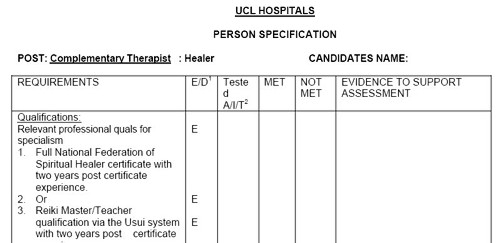
Follow-up
Steven Novella, at Science-Based medicine, has also written about this paper.
The mainstream media eventually catch up with bloggers. BBC1 TV (Wales) produced an excellent TV programme that exposed the enormous degree validation scam run by the University of Wales. It also exposed the uselessness of the Quality Assurance Agency (QAA). Both these things have been written about repeatedly here for some years. It was good to see them getting wider publicity.
Watch the video of the programme (Part 1, and Part 2) "Week In Week Out – University Challenged." “The programme examines how pop stars and evangelical Christians are running colleges offering courses validated by the University of Wales.” (I make a brief appearance, talking about validation of degrees in Chinese Medicine).
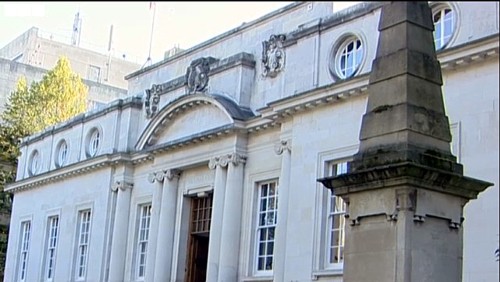
In October 2008 I posted Another worthless validation: the University of Wales and nutritional therapy. With the help of the Freedom of Information Act, it was possible to reveal the mind-boggling incompetence of the validation process used by the University of Wales.
McTimoney College of Chiropractic
The Chiropractic “degrees” from the McTimoney College of Chiropractic are also validated by the University of Wales by an equally incompetent, or perhaps I should say bogus, procedure. More details can be found at The McTimoney Chiropractic Association would seem to believe that chiropractic is “bogus”, and in a later post, Not much Freedom of Information at University of Wales, University of Kingston, Robert Gordon University or Napier University.
Andy Lewis has also written about chiropractic in The University of Wales is Responsible for Enabling Bogus* Chiropractic Claims to be Made.
Sadly the BBC programme did not have much to say about these domestic courses, but otherwise it was excoriating. In particular it had extensive interviews with Nigel Palastanga, whose astonishing admission that courses were validated withour seeing what was taught on them was revealed here two years ago. After that revelation, the vice-chancellor of UoW, Marc Clement BSc PhD CEng CPhys FIET FInstP, promoted Palastanga to be pro-vice-chancellor in charge of Learning, Teaching and Enhancement (I know, you couldn’t make it up).
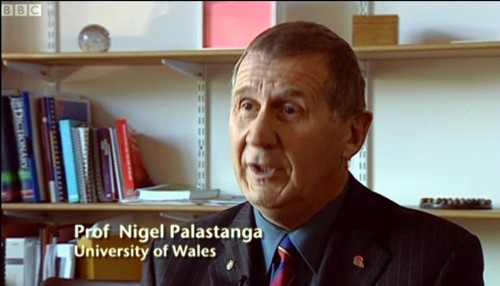
In the documentary Palastanga said
"It’s a major business. We earn a considerable amount of money."
That was obvious two years ago, but it’s good to hear it from the horse’s mouth.
After a section that revealed a bit about what goes on at two very fundamentalist bible colleges which gave University of Wales degrees, A. C. Grayling commented thus.
"They are there to train advocates for the biblical message and that is absolutely not, by a very very long chalk, what a university should be doing.. . . A respectable British Higher education institution like the University of Wales shouldn’t be touching them with a bargepole."
Undaunted, Palastanga responded
“That’s his opinion. I would say they are validated to the highest standards. They match what are called QAA benchmark. We have serious academics looking at them, and their academic standards are established at the very highest level.”
And if you believe that, you will truly believe anything.
You can download here one of many moderator’s reports obtained under the Freedom of Information Act. This one is for the BSc (Hons) Chiropractic. It is entirely typical of theuncritical boxticking approach to validation, Nowhere does it say "subluxation is nonsense", though even the GCC now admit that.
Traditional Chinese Medicine
The University of Wales validates several courses in what almost everyone but them classifies as quackery. As well as chiropractic and “nutritional therapy”, there is herbalism. For example a course at a college in Barcelona issues University of Wales degrees in Traditional Chinese medicine, a subject that is a menace to public health.. I was asked to comment on the course, and on a bag of herbs that the presenter had been sold to treat depression.
|
Radix Bupleuri Chinensis
Radix Angelicae Sinensis Radix Paeoniae Lactiflorae Rhizoma Atractylodis Macrocephalae Sclerotium Poriae Cocos Radix Glycyrrhizae Uralensis Cortex Moutan Radicis (Paeonia Suffruticosa) Fructus Gardeniae Jasminoidis Herba Menthae Haplocalycis Zingiber officinale rhizome-fresh |
 Ingredients of a custom mixture. |
There is no good evidence that any of the ingredients help depression, in fact next to nothing is known about most of them, apart from liquorice and ginger. Swallowing them would be rather reckless. They fall right into the description of any herbal medicine, in the Patients’ Guide, "Herbal medicine: giving patients an unknown dose of an ill-defined drug, of unknown effectiveness and unknown safety. "
Of the degrees, I said
"There’s no evidence that it [the herbs] does you any good. It may be dangerous because you have no idea of the dose. Degrees in Chinese Medicine consist of three years spent memorising myths and pre-scientific, er, untruths. That isn’t a degree, it’s a travesty."
Palastanga. responded
"We’ve had long debates in the Health Committee about where we would draw the line about what we validate. They have to demonstrate to us that there is some scientific basis for the practice, that there is an established curriculum, that there is an established safe practice."
The presenter asked him "So you are confident that Chinese medicine works? Palastanga replied
" I didn’t say that. I said that there is evidence that it does work . . We are trying to enforce these professions to undertake effective research."
That statement is simply not true, as shown by the response of the validation committee to the application for validation of the course in “Nutritional Therapy” at the Northern College of Acupuncture, documented previously. The fact of the matter is that the validation proceeded without looking at what was actually taught, and without even a detailed timetable of lectures. The committee looked only at the official documents presented to it and was totally negligent in failing to discover some of the bizarre beliefs of the people who were giving the course.
Palastanga went on to raise the usual straw man argument, about how little regular medicine is based on good evidence (though admittedly that is certainly true in his own field -he is a physiotherapist).
Fazley International College Kuala Lumpur

This business college in Kuala Lumpur offered University of Wales degrees. Its 32-year old president is a part time pop star with impressive looking qualifications
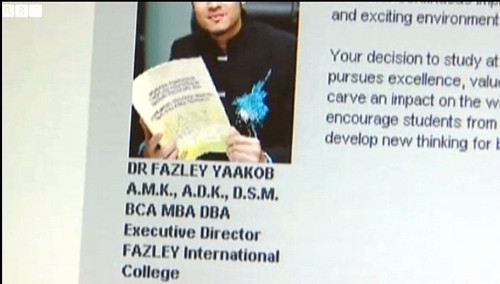
The presenter pointed out that
" His doctorate and his MBA were awarded in that citadel of education, Cambridge. Here he is, pictured at the city’s prestigious business school. He was there for all of four days and walked away with a doctorate. But the degree was not from the University of Cambridge, but from the now defunct "European Business School Cambridge". It never had the right to award degrees."
Neither the University of Wales nor the QAA had noticed this unfortunate fact. Once the TV team had done their job for them, the UoW withdrew support. though, as of 15 November 2010, that is not obvious from Fazley’s web site.
Mr (not Dr) Fazley seemed rather pleased about how students were attracted by the connection with the Prince of Wales. The fact that he is Chancellor of the University of Wales seems not inappropriate, given the amount of quackery they promote.
Quality Assurance Agency (QAA)
In 2007, I wrote, in Nature (see also here),
“Why don’t regulators prevent BSc degrees in anti-science? The Quality Assurance Agency for Higher Education (QAA) claims that “We safeguard and help to improve the academic standards and quality of higher education in the UK.” It costs taxpayers £11.5 million (US$22 million) annually. It is, of course, not unreasonable that governments should ask whether universities are doing a good job. But why has the QAA not noticed that some universities are awarding BSc degrees in subjects that are not, actually, science? The QAA report on the University of Westminster courses awards a perfect score for ‘curriculum design, content and organization,’ despite this content consisting largely of what I consider to be early-nineteenth-century myths, not science. It happens because the QAA judges courses only against the aims set by those who run the QAA, and if their aims are to propagate magic as science, that’s fine.”
That was illustrated perfectly in the documentary when Dr Stephen Jackson of the QAA appeared to try to justify the fact that the QAA had, like the University of Wales, failed entirely to spot any of the obvious problems. He had a nice dark suit, tie and poppy, but couldn’t disguise the fact that the QAA had given high ratings to some very dubious courses.
The QAA sent nine people to the other side of the globe, at a cost of £91,000. They could have done a lot better if they’d spent 10 minutes with Google at home.
Universities UK (UUK)
Needless to say, the Committee of Vice-Chancellors and Principals has said nothing at all. As usual, Laurie Taylor had it all worked out in Times Higher Education (4th November).
Speaking to our reporter Keith Ponting (30), he commended UUK’s decision to say absolutely nothing whatsoever about the abolition of all public funding for the arts and humanities.
He also praised UUK’s total silence on Lord Browne’s view that student courses should primarily be evaluated by their employment returns.
When pressed by Ponting for his overall view of UUK’s failure to respond in any way at all to any aspect of the Browne Review, he described it as “welcome evidence, in a world of change, of UUK’s consistent commitment over the years to ineffectual passivity”.
Meanwhile, a University of Wales video on YouTube
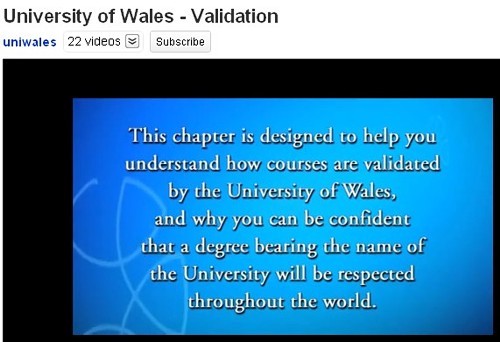
Caveat emptor
Follow-up
A couple of days later, a search of Google news for the “University of Wales” shows plenty of fallout. The vice-chancellor claims that ““The Minister’s attack came as a complete and total surprise to me”. That can’t be true. It is over two years since I told him what was going on, and if he was unaware of it, that is dereliction of duty. It is not the TV programme that brought the University into disrepute, it was the vice-chancellor.
 . Sign at http://libelreform.org/
. Sign at http://libelreform.org/
Freedom of speech in everyday life is a beautiful and hard-won fundamental liberty. I can say what I like about the prime minister and the royal family. There will be no knock on the door in the night.
Bur as a scientist, I cannot express an opinion on a scientific question freely. That is not, thank heavens, because of the government, the military or the police. It is because of a bunch of despicable lawyers who take advantage of an unjust law to make vast amounts of money. Do Carter-Ruck care if I’m made homeless and my son loses his education? They don’t give a damn.
The present libel law in the UK is a threat to journalists and, even more, to bloggers most of whom have little money. Still worse it endangers science itself. You cannot safely write an article in a scientific journal If your conclusions are unfavourable to a rich company, for fear that they will sue and you’ll end up sleeping in a tent.
The lie detector scandal
One good example concerns lie detectors. They don’t work and quite probably never will work. Nevertheless they sound like a very good idea to scientifically-illiterate government departments, police and military people. A recent report of the Lacerda case summarised the problem.
In 2007, Professor Lacerda and Anders Eriksson, of Gothenburg University, published an article entitled “Charlatanry in Forensic Speech Science” in the International Journal of Speech, Language and the Law. It criticised the science behind analysis technologies that purport to identify stressed voices, which may indicate lying.
One VRA system, designed by Nemesysco, an Israeli company, is being evaluated in 24 pilot studies by the DWP [Department of Work and Pensions], as a means of highlighting potential benefit fraud. The DWP has spent £2.4 million on the pilots, which are due to report back soon. Nemesysco threatened the journal with a libel action over the article, which was withdrawn from its website.
The system was tested properly. Like all others of its sort it didn’t work. That, no doubt, is bad for the income of the people who make it, Nemesysco,as it should be. But instead of the company being convicted for selling devices that don’t work, the company hired lawyers and forced the journal to withdraw the paper, on threat of destitution.
The current case of Dr Peter Wilmshurst
|
Peter Wilmshurst is a consultant cardiologist at the Royal Shrewsbury Hospital. Like any good doctor he likes to ensure that the tools of his trade actually work as advertised. The Times reported thus. |

|
Dr Wilmshurt’s case began with his involvement in a study of a medical device made by NMT called Starflex, designed to close a type of hole in the heart known as a patent foramen ovale (PFO). The study investigated Starflex as a potential treatment for migraine, which is significantly more common among people with a PFO, but failed to find benefits.
At a cardiology conference in Washington in 2007, Dr Wilmshurst criticised NMT Medical in relation to the research. His comments were reported by Heartwire, a website, prompting NMT to sue him.
This sort of behaviour by a medical company is utterly disgraceful. One would think that the fact that their actions had made the company name, NMT Medical, a laughing stock might have inhibited them, but far from that working, they recently launched a second legal action against Wllmshurst. The details are given by the Health Watch web site, and by legal blogger Jack of Kent.
It is small consolation to Dr Wilmshurst, as he faces destitution, that a Google search for "NMT medical" brings up on the first page a link to More news of NMT Medical MIST Trial – false declarations. This provides an excellent report on the technicalities. It is on the Scientic Misconduct blog, written by Aubrey Blumsohn, who has himself suffered for being honest in the face of corporate misconduct (in his case the villains were the University of Sheffield, in particular Prof Richard Eastell, and Proctor and Gamble. see also this blog),
Boob job cream
The latest case concerns Plastic surgeon threatened for comment on ‘Boob Job’ cream. She’s been sued for doing her job by saying that a cream costing £125 per jar cannot, as claimed, increase your bust size.
Not content with threatening the surgeon. The company, Rodial Ltd. also threatened Sense About Science if they publicised the case. They haven’t yielded to that threat.
The company should be prosecuted by Trading Standards for making illegal false health claims. But Trading Standards don’t do their job. Instead another honest clinician faces ruin
My own brushes with lawyers
I have experienced myself the cold terror of getting a letter from lawyers. In my case it came from the New Zealand Chiropractic Association after I’d written an editorial for the New Zealand Medical Journal, Doctor Who? Deception by chiropractors. It got to the stage of wondering whether the house could be put solely in my wife’s name, but in this case, thanks to a feisty response from the Journal editor, the chiroquacks backed off.
This blog itself was born as a result of legal threats against UCL by a couple of herbalists who were cross because I described the term "blood cleanser" as gobbledygook. The fact that this is true was irrelevant. Tnanks to lots of publicity the outcome for me was good, a vast increase in readership.
What you can do
The present libel law in the UK is notoriously the most iniquitous and expensive in the world. It is a national disgrace. It isn’t a new problem. One of my predecessors in the Chair of Pharmacology at UCL, A. J. Clark, was forced to apologise for a perfectly true statement made in his 1938 book on Patent Medicines.
The government has promised to change it but a huge amount of work to be done to make sure it is changed to something more civilised. There are a lot more lawyers in government than scientists (well, about one scientist). There is good reason to think that they will try to subvert the changes that are needed.
Support the campaign run jointly by English PEN, Index on Censorship and Sense About Science.
Get every friend to sign the petition. Ask your students to sign it. Write to your MP. And ask your friends from every country to sign it. Anyone in the world can be sued in UK courts. The present UK law doesn’t endanger only UK science, but it endangers science, and honesty itself, over the globe.
Keep up the pressure for a sensible reform..
 . Sign at http://libelreform.org/
. Sign at http://libelreform.org/
Follow-up
The Prince of Wales’ Foundation for Integrated Health shut down amidst scandal in April 2010. In July, we heard that a new “College of Medicine” was to arise from its ashes. It seemed clear from the people involved that the name “College of Medicine” would be deceptive.
Now the College of Medicine has materialised, and it is clear that one’s worst fears were well justified.

At first sight, it looks entirely plausible and well-meaning. Below the logo one reads
“There is a new force in medicine. A force that brings patients, doctors, nurses and other health professionals together, instead of separating them into tribes.”
"That force is the new College of Medicine. Uniquely, it brings doctors and other health professionals together with patients and scientists.”
It is apparent from the outset that the well-meaning words fall into the trap described so clearly by James May (see What ‘holistic’ really means). It fails to distinguish between curing and caring.
As always, the clue lies not in the words, but in the people who are running it.
Who is involved?
After a bit of digging on the web site, you find the names of the people on the Science Council of the “College of Medicine”, The preamble says
“Good medicine must be grounded in good science as well as compassion. The College’s Science Council brings a depth of knowledge from many senior figures.”
But then come the names. With the odd exception the “science council” is like a roll-call of quacks, the dregs left over from the Prince’s Foundation. The link (attached to each name) gives the College’s bio, My links tell a rather different story.
-
Professor George Lewith You’ll find plenty about George Lewith on this blog.
-
Professor Mustafa Djamgoz Superficially respectable but seduced by ‘ancient wisdom’ He once wrote to me "There are many ‘eastern’ remedies (such as acupuncture that we witnessed dismissed 25 year ago) that work. ". Well it isn’t as simple as that.
-
Professor Simon Gibbons A phytochemist with exaggerated ideas of what you can get from plants.
-
Professor Jane Plant A respectable geochemist who became obsessed with alternative medicine, Read about her here,
-
Dr Peter Fisher The Queen’s Homeopathic Physician. Advocate of the most discreded of all forms of quackery. Lots about him here.
-
Dr Michael Loughlin A post-modernist-influenced theorist who hates Ben Goldacre. Read about him here.
-
Dr Hugh MacPherson An acupuncturist and fellow traveller of the Prince of Wales. Read here.
-
Professor Andrew Miles I’m sorry to see him in this company after the good job he did in ejecting quacks at the University of Buckingham.
-
Simon Mills A man who thinks herbs can be classified as "hot"and "cold", See here and here
-
Professor Nicola Robinson Head of the Centre for Complementary Healthcare & Integrated Medicine,Thames Valley University A well known advocate of unevidenced treatments. Try Googling her
-
Dr Catherine Zollman Another hangover from the Princes’ Foundation, and believer in magic medicine
It seems that the "Scientific Council" of the College of Medicine could more properly be called an "Antiscientific Council".
There are a few gaps in this table, to be filled in soon. One can guarantee that a great deal more will appear about the College on the web, very soon.
The Governing Council of the College is equally replete with quacks (plus a few surprising names). It has on it, for example, a spiritual healer (Angie-Buxton King), a homeopath (Christine Glover), a herbalist (Michael McIntyre). Westminster University’s king of woo (David Peters), not to mention the infamous Karol Sikora. Buxton-King offers a remarkable service to heal people or animals at a distance.
Meanwhile, it seemed worthwhile to provide a warning that the title of the College is very deceptive. It hides an agenda that could do much harm.
It is, quite simply, the Prince of Wales by stealth.
Follow-up
28 October 2010
Professor Sir Graeme Catto, who has, disgracefully, allowed his name to be used as president of this “College” has said to me “There are real problems in knowing how to care for folk with chronic conditions and the extent of the evidence base for medicine is pretty limited”.
Yes of course that is quite true. There are many conditions for which medicine can still do little. There is a fascinating discussion to be had about how best to care for them. The answer to that is NOT to bring in spiritual healers and peddlers of sugar pills to deceive patients with their fairy stories. The “College of Medicine” will delay and pervert the sort of discussion that Catto says, rightly, is needed.
29 October 2010
I need a press card. I see that the BMJ also had a piece about the “College of Medicine” yesterday: Prince’s foundation metamorphoses into new College of Medicine, by Nigel Hawkes. He got the main point right there in the title.
As was clear since July, the driving force was Michael Dixon, Devon GP and ex medical director of the Prince’s Foundation. Hawkes goes easy on the homeopaths and spiritual healers, but did spot something that I can’t find on their web site. The “Faculties” will include
“in 2011, neuromusculoskeletal care. Two of the six strong faculty members for this specialty are from the British Chiropractic Association, which sued the author Simon Singh for libel for his disobliging remarks about the evidence base for their interventions.”
The College certainly picks its moment to endorse chiropractic, a subject that is in chaos and disgrace after they lost the Singh affair.
One bit of good news emerges from Hawkes’ piece, There is at least one high profile doubter in the medical establishment, Lord (John) Walton (his 2000 report on CAM was less than blunt, and has been widely misquoted by quacks) is reported as saying, at the opening ceremony
“I’m here as a sceptic, and I’ve just told my former houseman that,” he said. The target of the remark was Donald Irvine, another former GMC president and a member of the new college’s advisory council.”
31 October 2010. I got an email that pointed out a remarkable service offered by a member of College’s Governing Council. Angie Buxton-King, a “spiritual healer” employed by UCLH seems to have another web site, The Beacon of Healing Light that is not mentioned in her biography on the College’s site. Perhaps it should have been because it makes some remarkable claims. The page about distant healing is the most bizarre.
Absent Healing/Distant Healing
"Absent healing is available when it is not possible to visit the patient or it is not possible for the patient to be brought to our healing room. This form of healing has proved to be very successful for humans and animals alike."
"We keep a healing book within our healing room and every night spend time sending healing to all those who have asked for it. We have found that if a picture of the patient is sent to us the healing is more beneficial, we also require a weekly update to monitor any progress or change in the patients situation. Donations are welcome for this service."
I wonder what the Advertising Standards people make of the claim that it is “very successful”? I wonder what the president of the College makes of it? I’ve asked him.
Other blogs about the “College of Medicine”
30 October 2010. Margaret McCartney is always worth reading. As a GP she is at the forefront of medicine. She’s written about the College in The Crisis in Caring and dangerous inference. She’s also provided some information about a "professional member" of the College of Medicine, in ..and on Dr Sam Everington, at the Bromley by Bow Centre….
It is one of the more insulting things about alternative medicine addicts that they claim to be the guardians of caring (as opposed to curing), They are not, and people like McCartney and Michael Baum are excellent examples.
Prince of Wales to become honorary president of the “College of Medicine?”
Last night I heard a rumour that the Prince of Wales is, despite all the earlier denials, to become Honorary President of the “College”. If this is true, it completes the wholesale transformation of the late, unlamented, Prince’s Foundation for Integrated Medicine into this new “College”. Can anybody take it seriously now?
Text messages to Graeme Catto and Michael Dixon, inviting them to deny the rumour, have met with silence.
Herbal nonsense at the College
29 July 2011. I got an email from the College if Medicine [download it]. It contains a lot of fantasy about herbal medicines, sponsered by a company that manufactures them. It is dangeroous and corrupt.




